

Project Name: Floating Cornice on
the Brook of Zhejiang Conservatory of Music
Location: Hangzhou, Zhejiang
Design Firm: line+ & gad
Chief Architect /
Project Principal: Zhu
Peidong
Chief Landscape
Designer: Li
Shangyang
Design Team: Sun Xiaoyu, Zhou
Yang (Architecture); Jin Jianbo, Zhang Wenjie, Chi Xiaomei (Landscape)
Floor Area: 409 Square Meters
Design Time: 2020.7-2020.9
Construction Time: 2021.4-2021.9
Client: Zhejiang
Conservatory of Music
Structural Design
Firm: Zhejiang Greentown Architectural Design Co., Ltd.
Design Team: Li Baozhong, Gao Yi
Structure: Steel Structure
Material: Deep Carbonized
Burned Fir Board, Red Cedar Board with Anticorrosion Treatment
Photography: Zhu Runzi, line+,
Yao Li
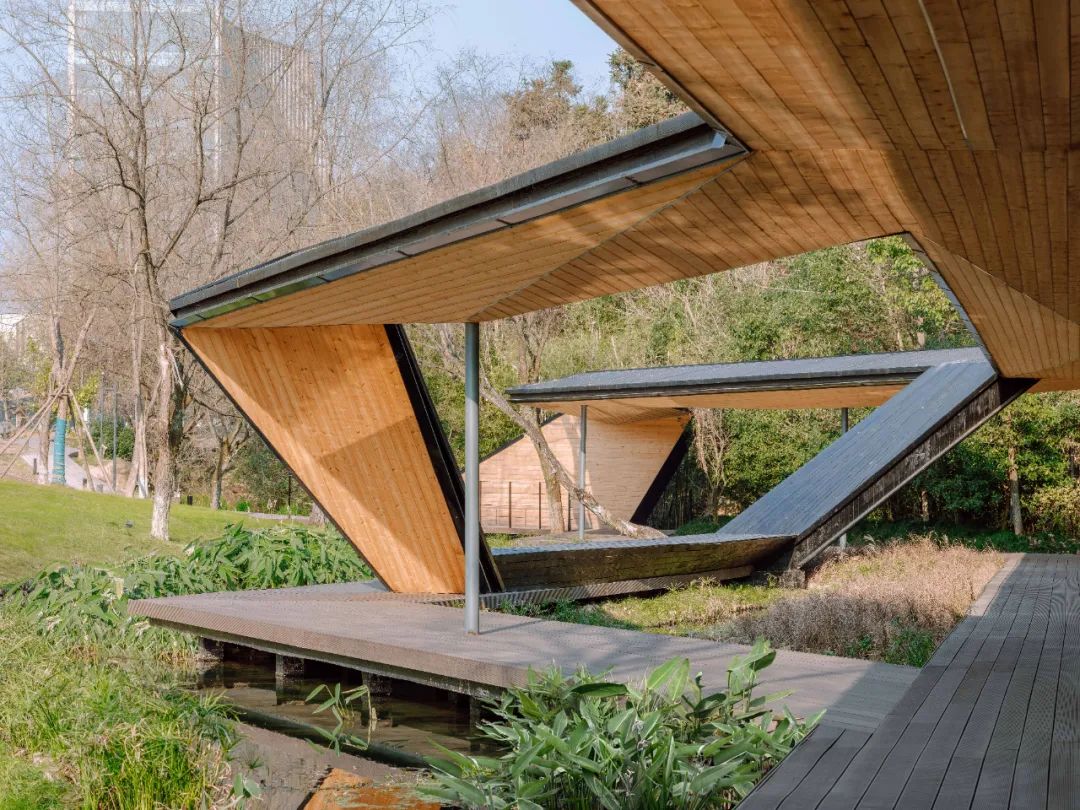
Zhejiang Conservatory of Music, where " Floating Cornice on the Brook” is located, the country's tenth and only newly constructed professional music education college. At the time of the design competition ten years ago, reflecting on the current pattern of conventional enclosed universities surrounded by walls, Zhu Peidong, the Chief Architect, has tried to take "an Open Music Art Park" as a new spatial prototype, and operated in the form of landscape and settlement namely "Flowing Landscape, Hidden Mountain Residence" - the operation of this landscape and settlements – to breaks away from the scale and interface of the traditional university campus to seek a more free and open new spatial prototype of art college construction.
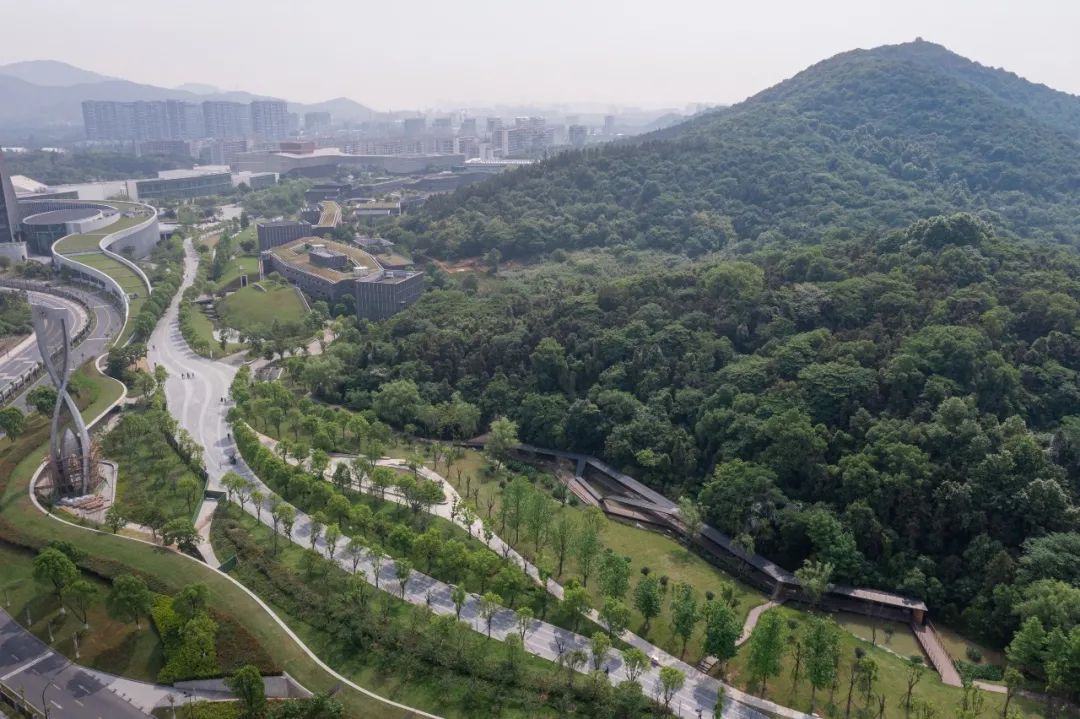
△ Take "an Open Music Art Park" as a new spatial prototype
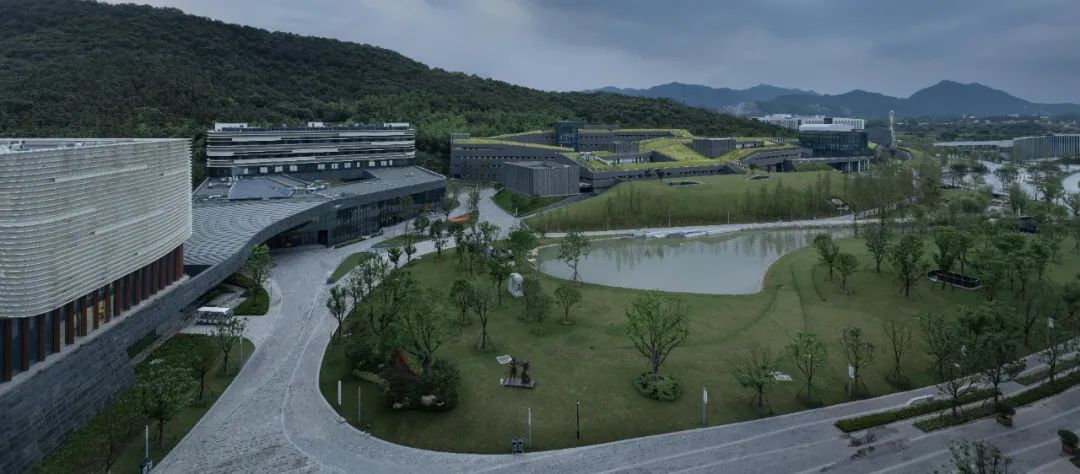
△ Flowing Landscape, Hidden Mountain Residence
Since
the campus was built and put into use in 2015, with the gradual running-in of
the campus software and hardware supports, and the improvement of the operation
and maintenance management level, the management team of the college decided to
declare the whole campus as a 4A cultural tourist attraction. Thus, it provides
us with a practice opportunity to continue the original intention of design in
the form of campus micro-renewal, and helps the campus to expand its
identity connotation from the "open campus" at the design level to
the "public scenic spot" at the social and ecological level.
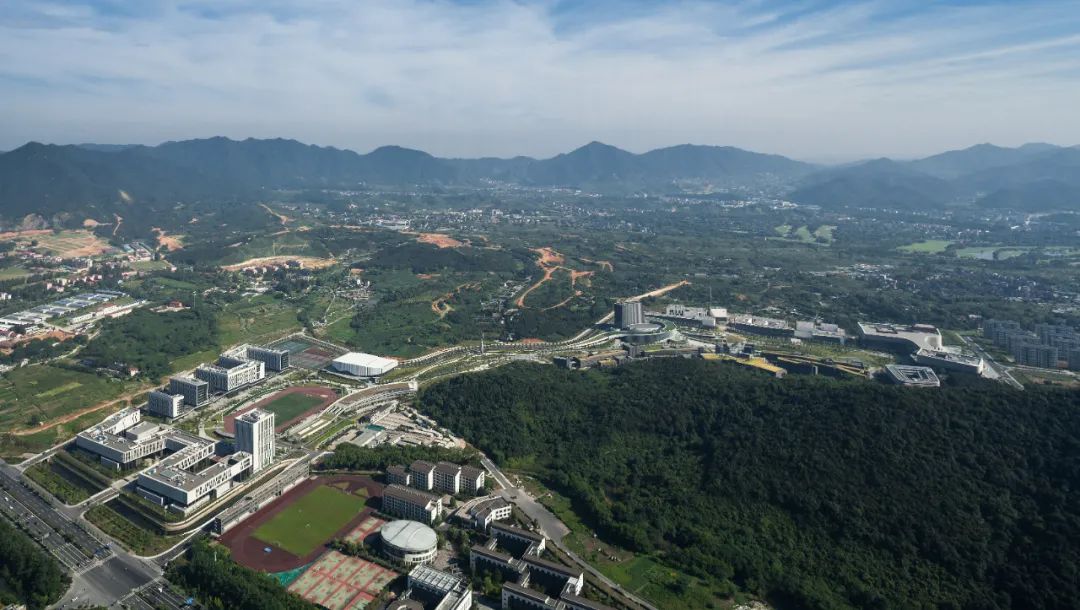
| 01 |
Linear Embedding: North-South
Connecting
The layout of campus
buildings varies with the land use and is divided into two groups, north and
south, with distinct morphological characteristics and distinction. On the
north side, it is the natural landscape architecture embedded in the mountain
and on the south side,it is the ceremonial space with clear artificial boundaries. The
design leaves the middle part blank, connecting the north and south campus
groups with flowing curving walkways, meandering channels along the mountain
and natural landscape.

△ Parallel corridors, connecting north-south
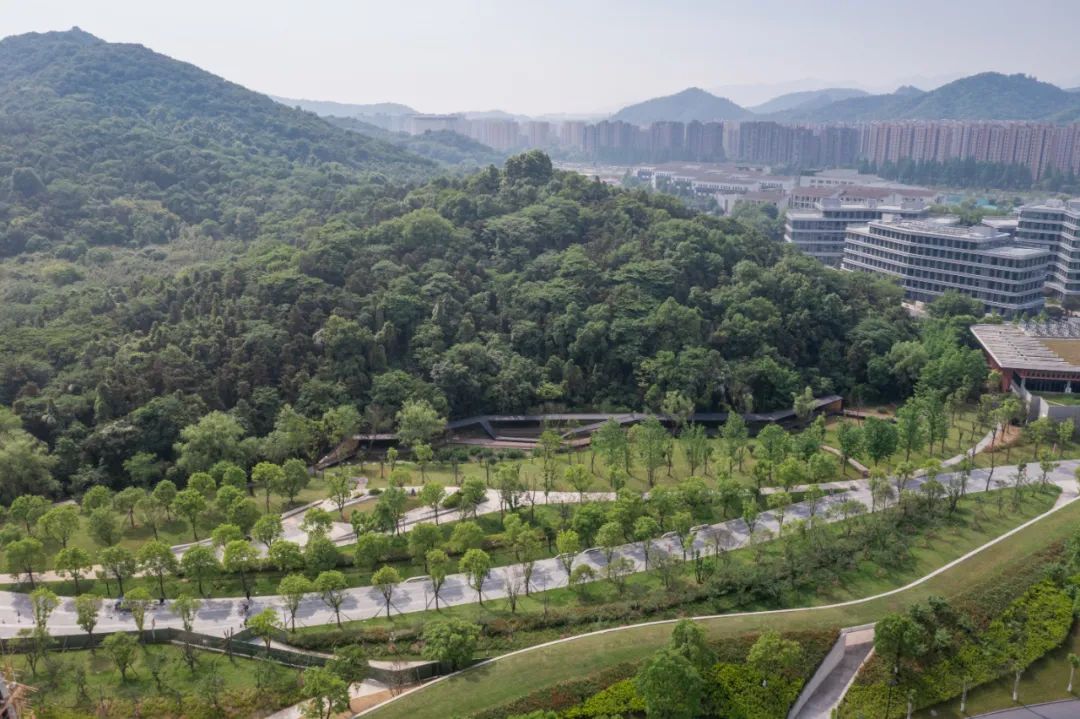
As an important
infrastructure upgrade for the campus 4A scenic spot evaluation, strengthening
the public attributes of the middle section of the campus and activating the
existing campus space have become the proposition purpose of our Open-ended
micro-renewal.
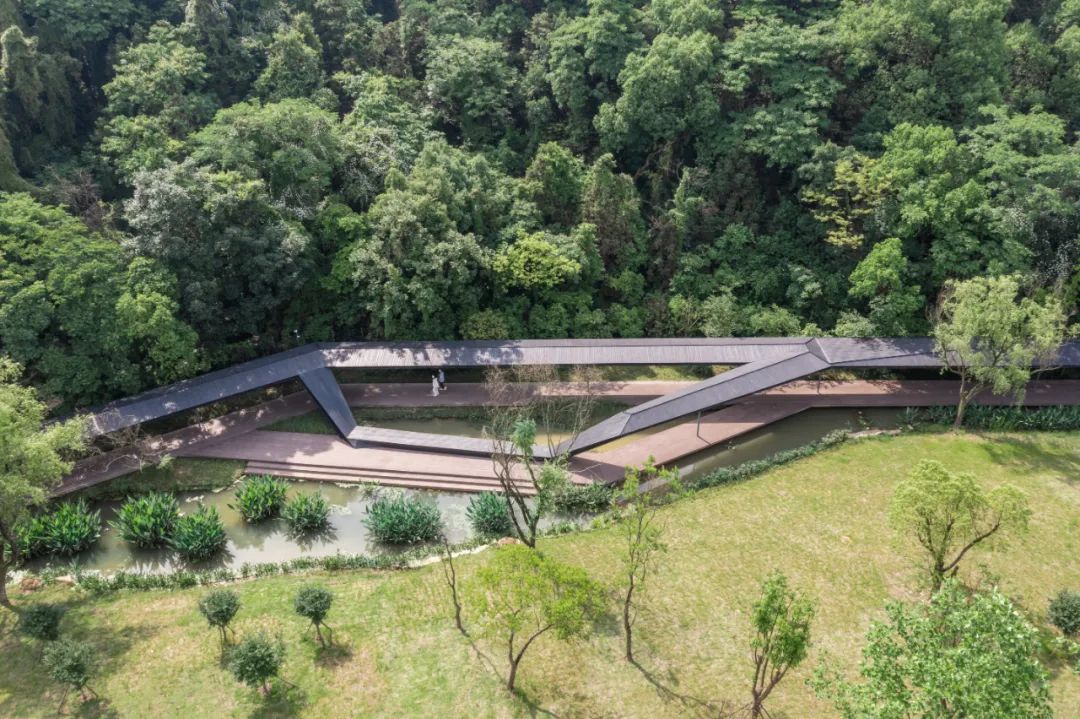
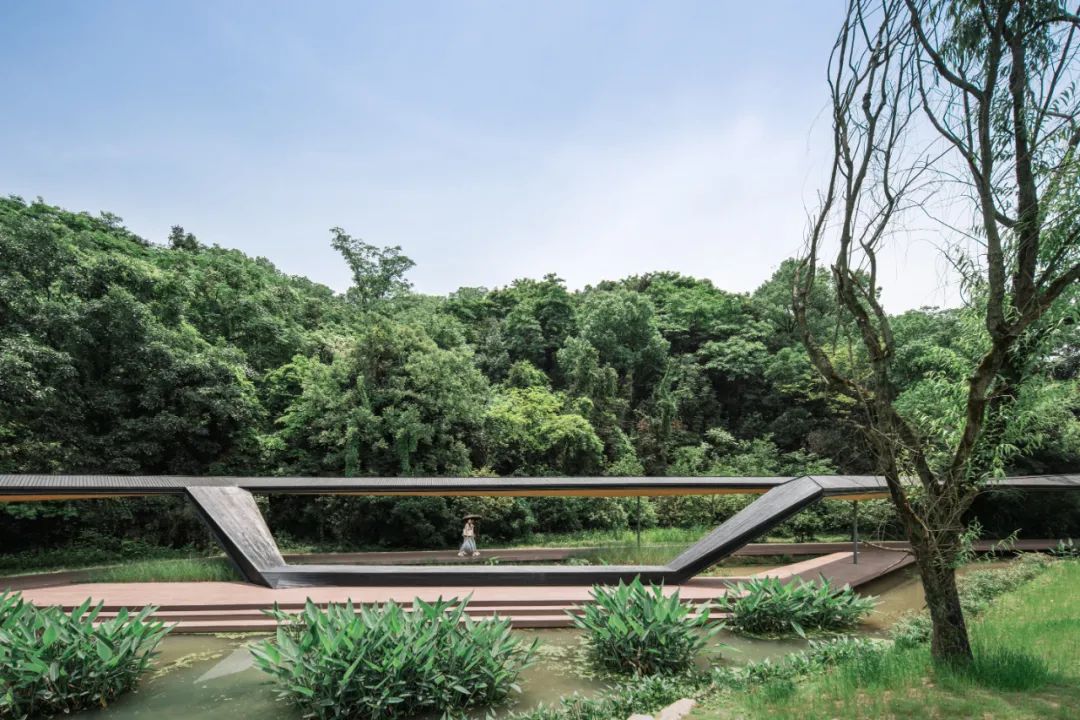
Through the retrospection of our original design intention at that time, combined with the current new needs of development inside and outside the campus, we finally selected the rainwater garden along the mountain canal in the middle section of the campus, which was originally left blank, and embedded a linear pedestrian system with minimal intervention approach on the site.

△ Original site
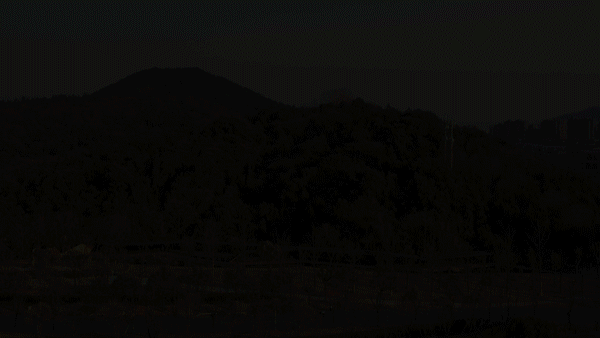
Borrowing from the traditional Chinese painting technique of scattered perspective and translating the spatial elements of "Plank, Corridors, Cornice, Bridges" of classical Chinese gardens, we try to superimpose multiple focal points, spatial forms and behavioral scenes in the longitudinal space of Floating Cornice on the Brook, so that people can gain a circuitous and diversified spatial experience and reading perspective when walking and viewing, aiming to activate the existing inefficient vacant space in this section of campus and improve the campus public roaming experience.
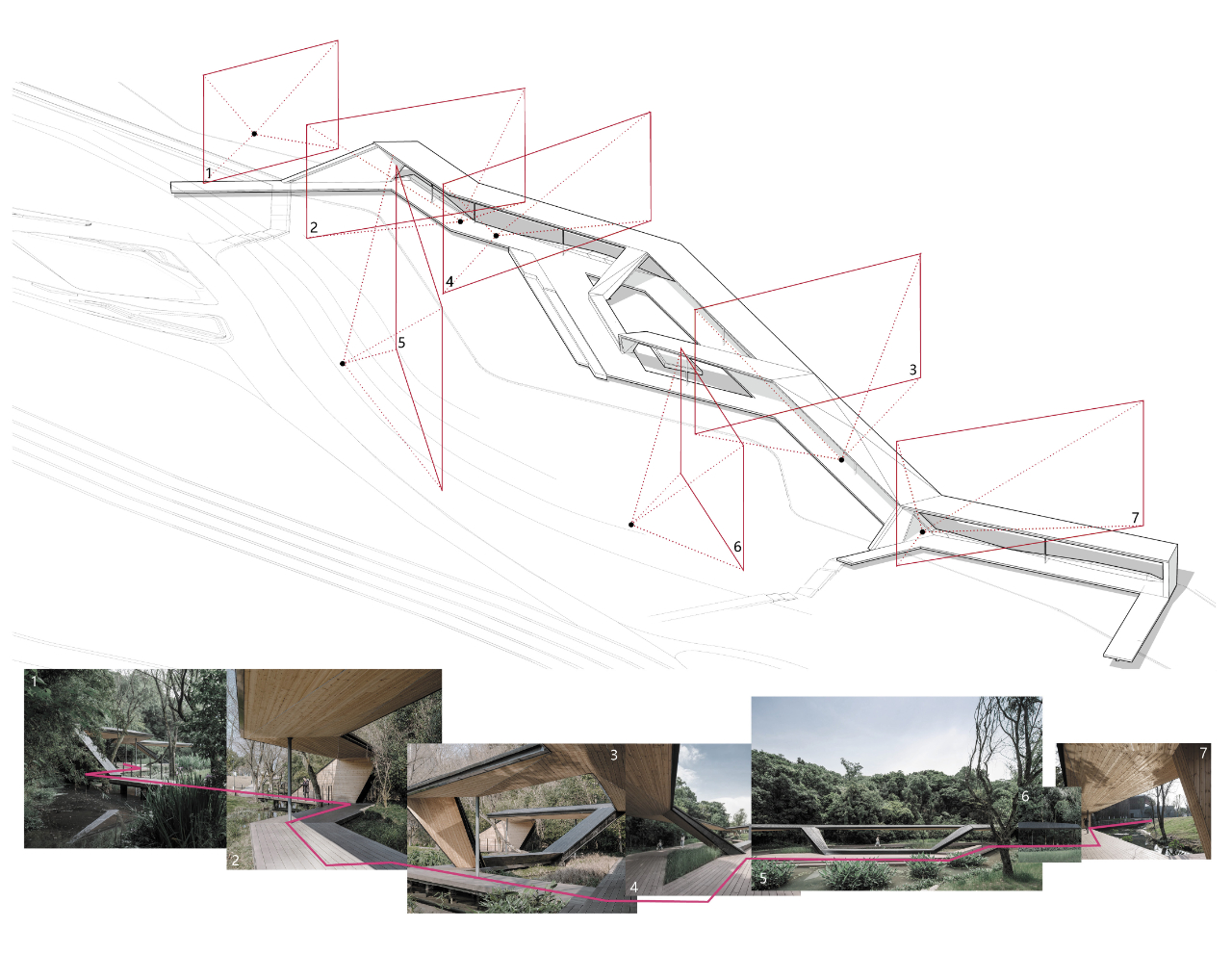
△ Scattershot perspective analysis
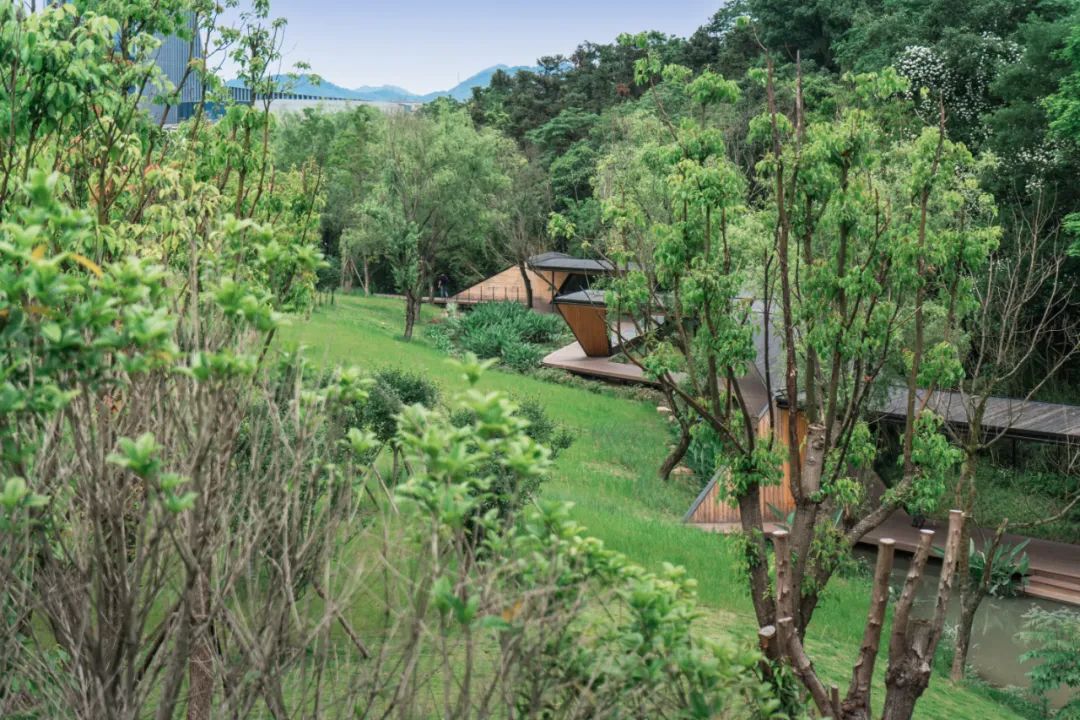
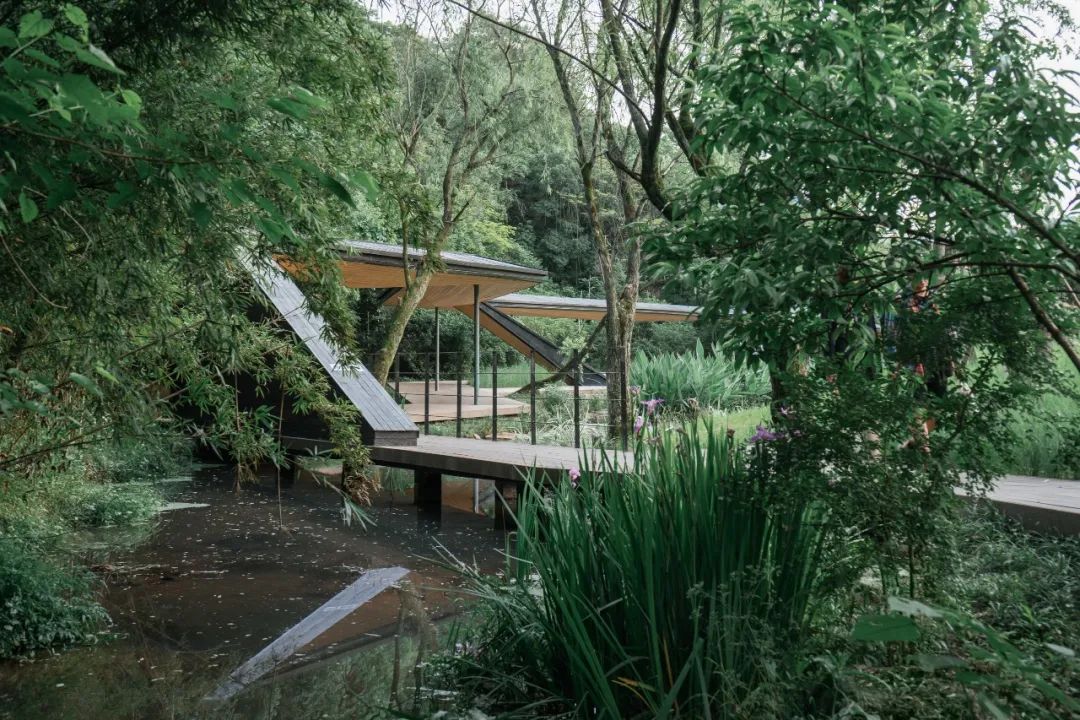
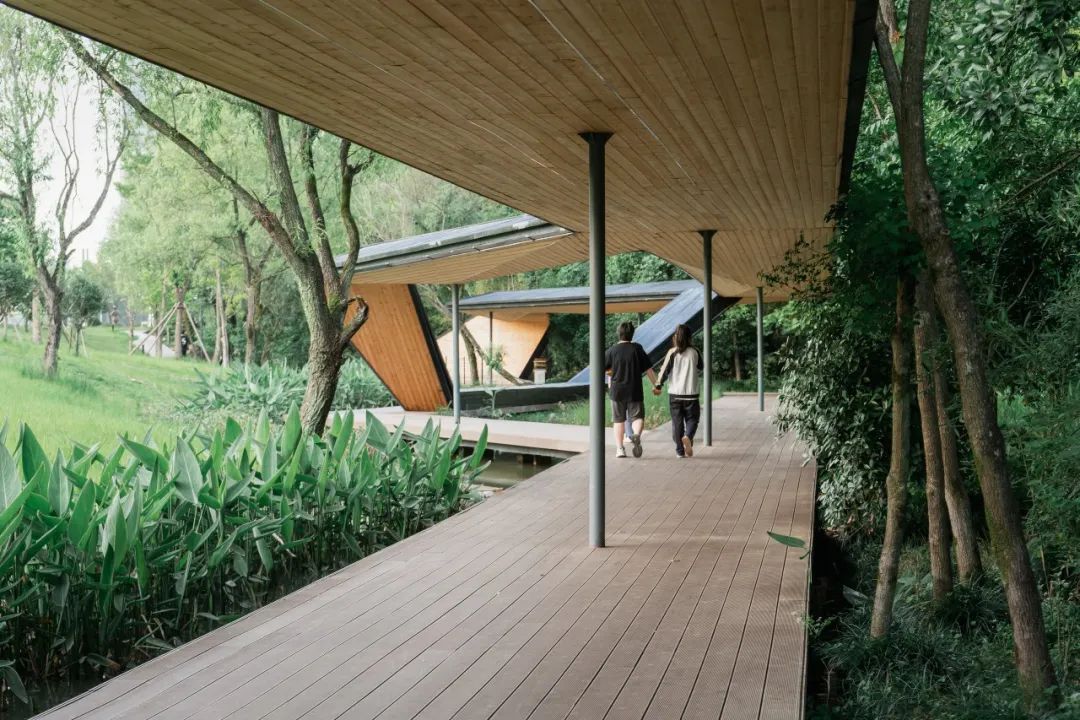
On the north side of Floating Cornice on the Brook, the wooden plank path gently floating on the ground is used as the guide, connecting the music department building which fades along the mountain and entwines with the remaining sound; On the south side, it ends with the unilateral cantilevered steel bridge and platform base, facing the campus canteen that linear spread out on the ground. Thus, it has formed the natural walking path at the foot of Wangjiang Mountain, providing a new experience of walking from north to south of the campus through woods and Brooks for teachers and students and visitors.
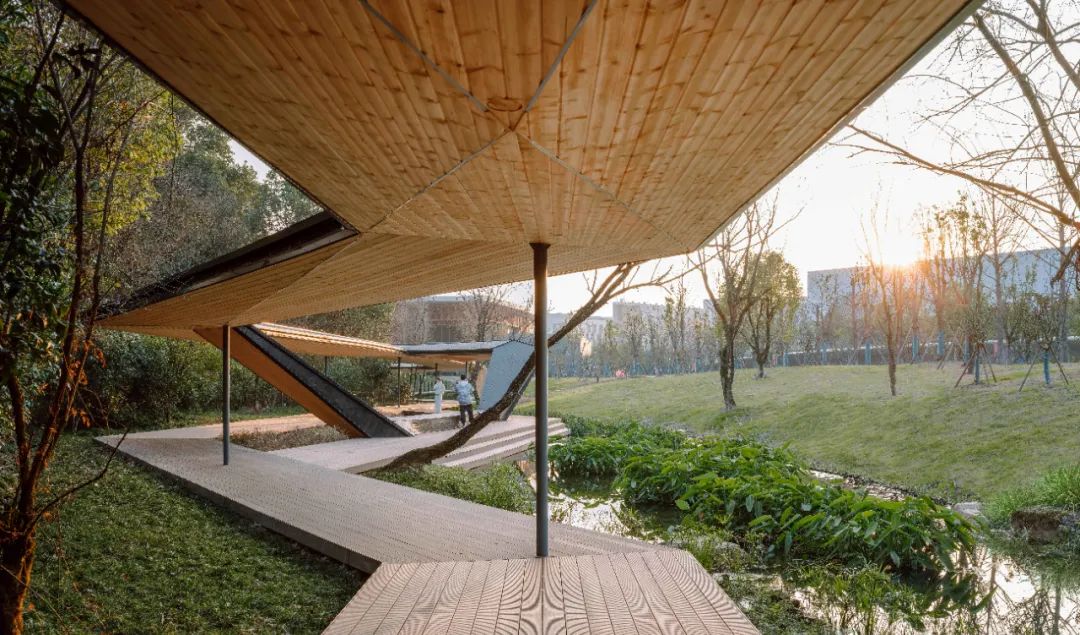
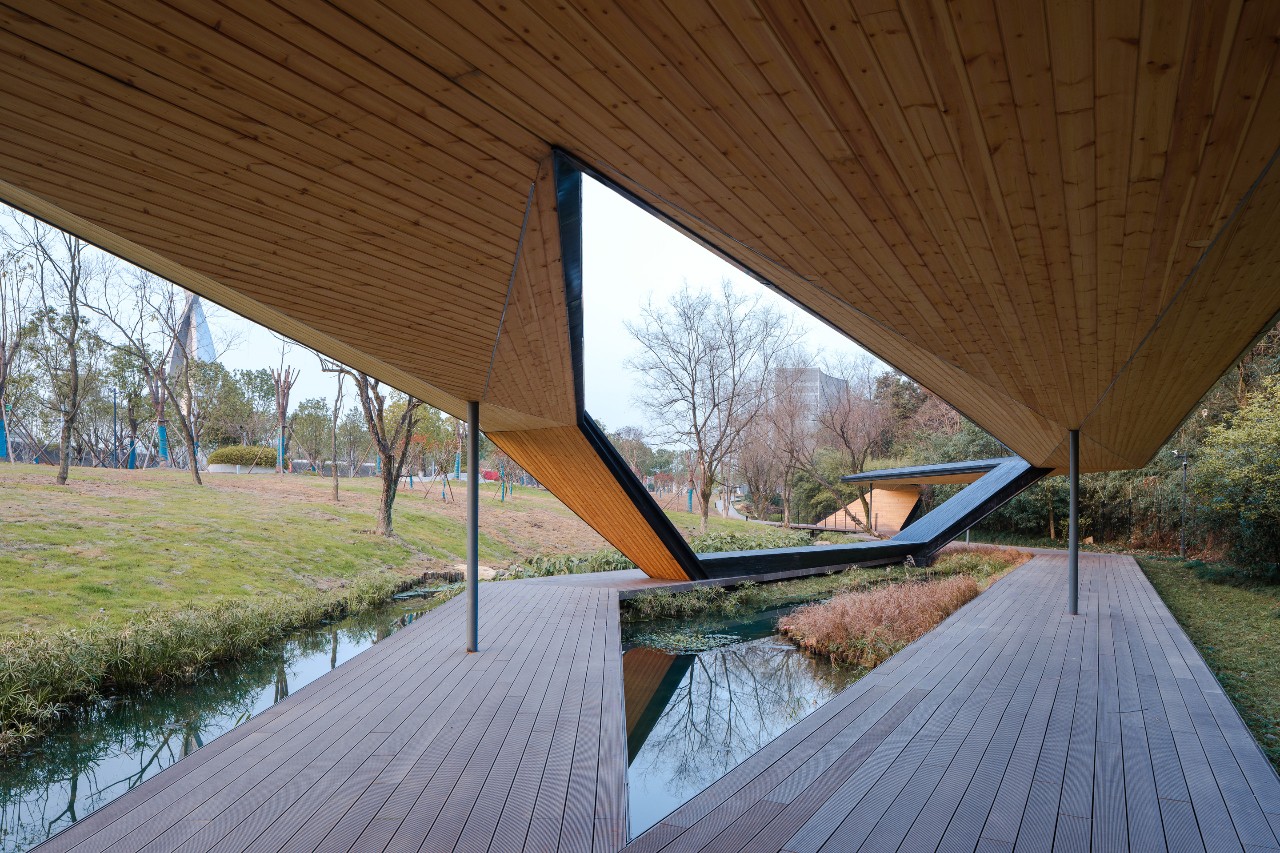
△ A new experience of walking from north to south of the campus
| 02 |
Parallel Corridors: East-West
Dialogue
In the boundary of
the campus’ central part of, the newly-built Floating Cornice on the Brook and
the Cloud Corridor in the Valley of Music, which has been in use for many
years, are parallel, integrating into the natural mountain scenery in the
middle of the campus, forming a campus public space system that can induce
diversified daily behaviors. Ten years ago, Cloud Corridor in the Valley of
Music was designed in accordance with the overall concept of the campus,
emphasizing the design entry point of soft curves and flowing landscape. The
solid volume of fair-faced concrete contains the delicate texture shaping by
board grain, and at present constitutes the established design basis for our
campus micro-renewal.
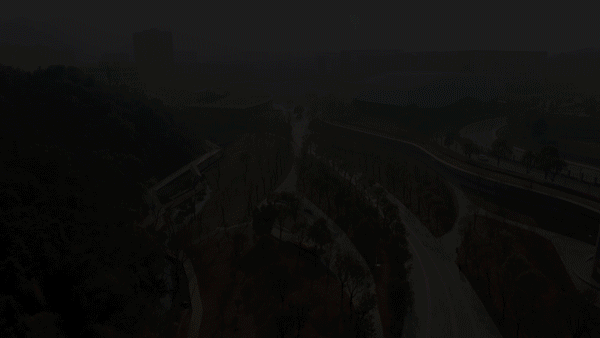
The new steel and
wood folding corridor Floating Cornice on the Brook on the east side and
concrete corridor Cloud Corridor in the Valley of Music on the west side are
added. One is light and the other is heavy, one is virtual and the other is
real, one is folding and bending, one is soft and the other is rigid. They
connect the north and south of the campus in different ways, and form a
dialogue spanning over a decade in the form and topography, structure and
materials of each other. They form the hidden boundary of Zhejiang Conservatory
of Music facing the Natural Mountain and gentle slope landform in the middle.
In the corridor, in line with the flowing space structure of the campus, the
landscape presents a geometric linear shape. The landscape road and corridor
are like melody and notes, guiding the crowd to move dynamically across the
campus.
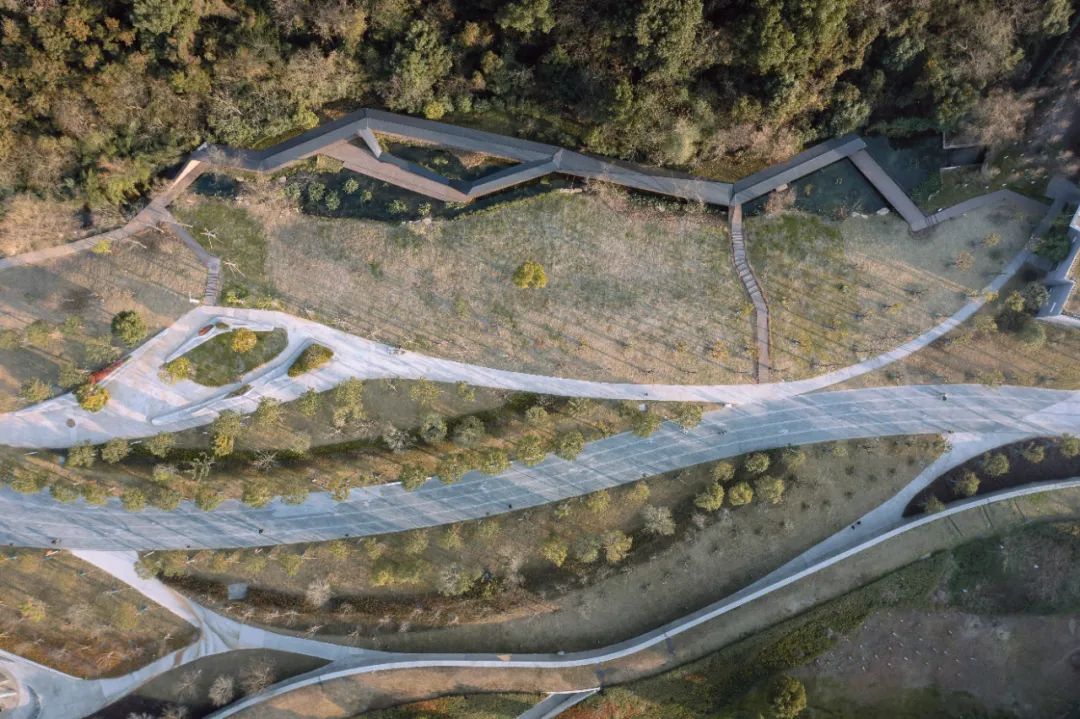
△ A dialogue spanning over a decade between Floating Cornice on the Brook and Cloud Corridor in the Valley of Music
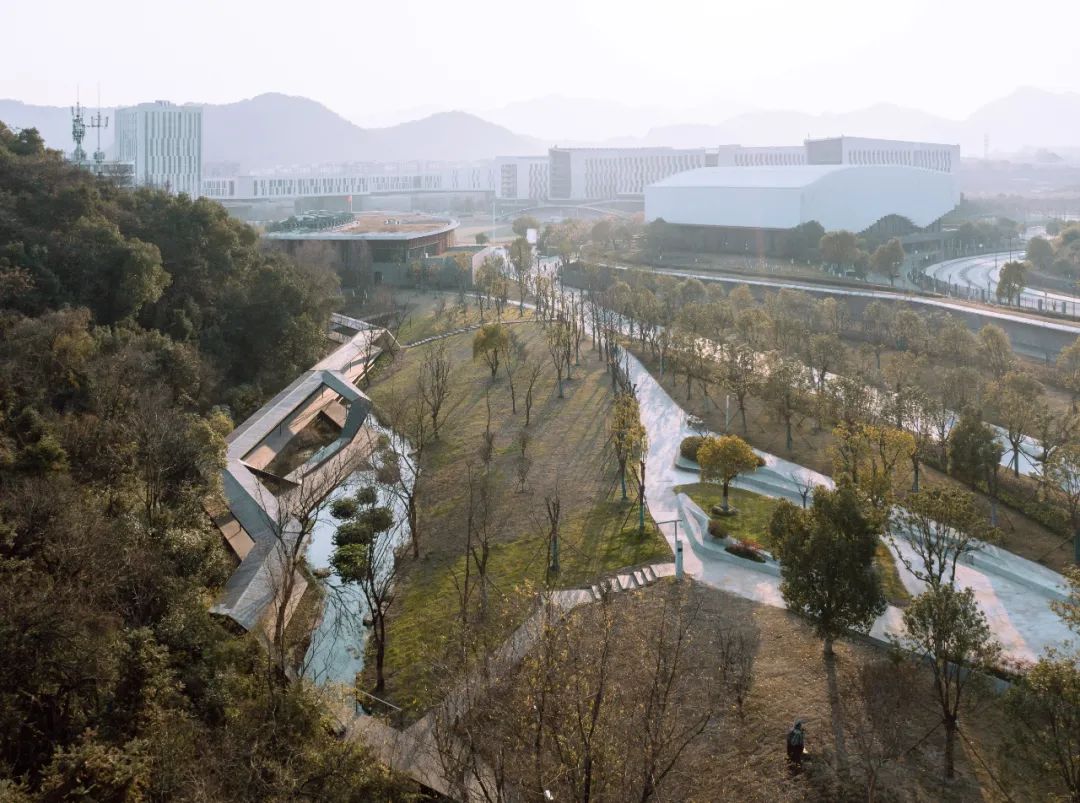
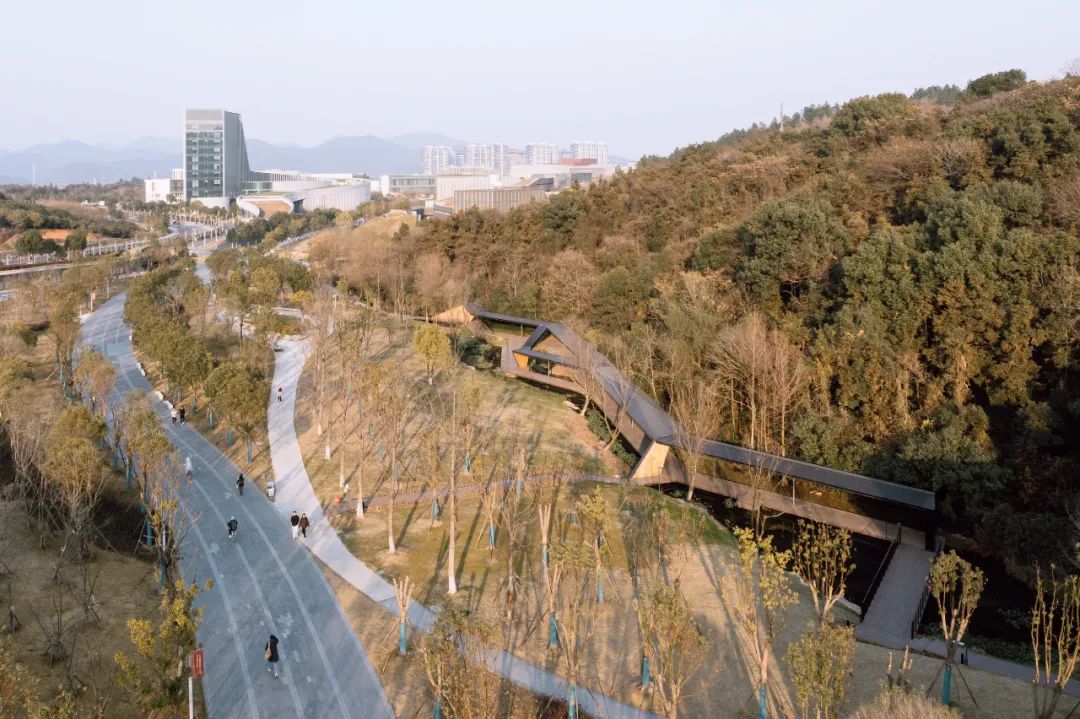
△ A north-south view of the Floating Cornice on the Brook
| 2.1 Topological Relations |
Crossing
the Brook and through the Trees / Meandering along the campus boundary
Cloud Corridor in
the Valley of Music forms barrier blocking the noise with half-open fair-faced
concrete corridor, while the Floating Cornice on the Brook leads the mountain
into the garden with fully transparent steel and wood folding corridor. The
concrete corridor curve is soft and steel and wood folding corridor twists and
turns with distinct nodes. The corridor of the two materials follows their own
terrain characteristics to interpret the two forms of the corridor.
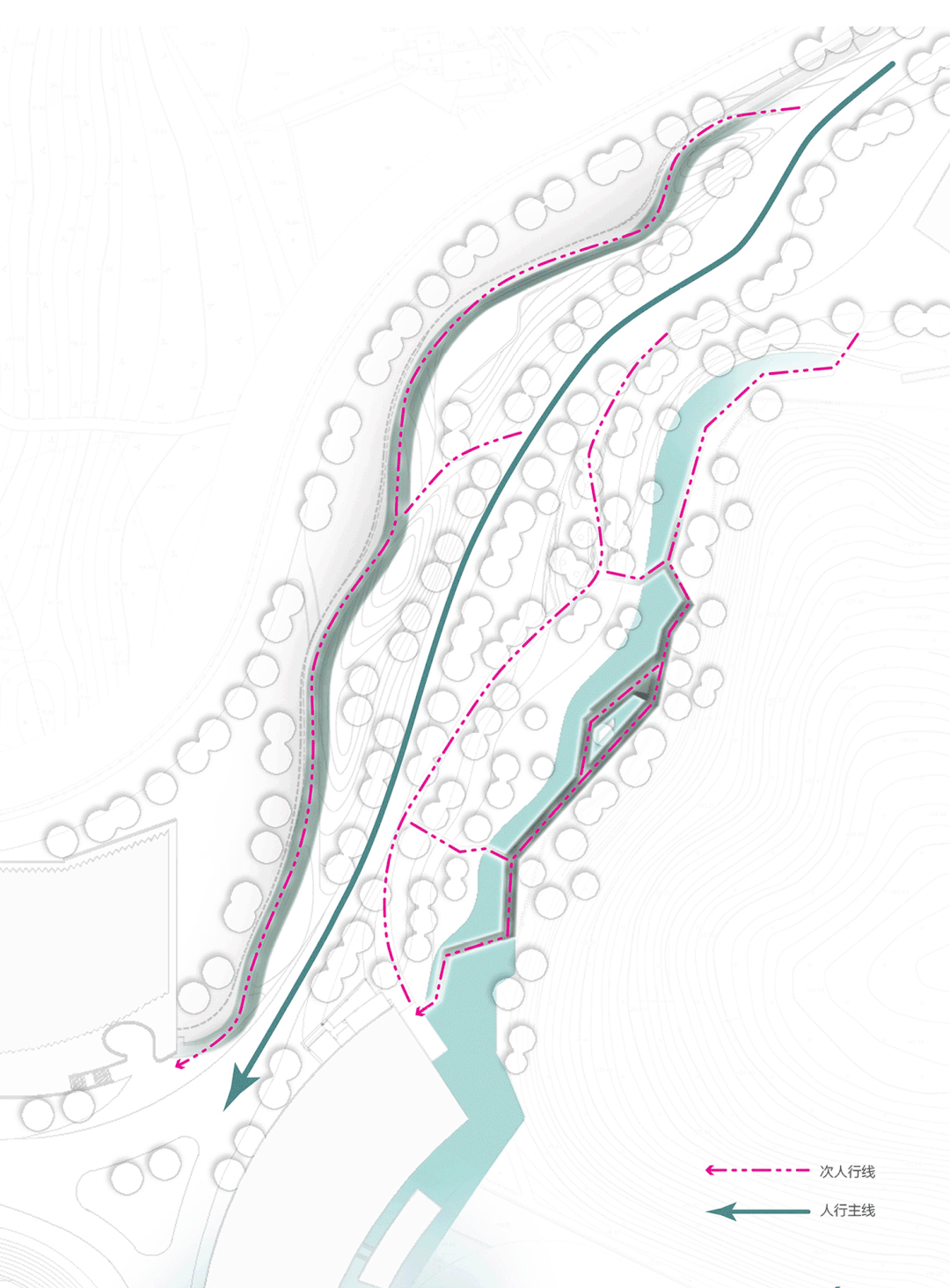
△ Pedestrian flow and vegetation analysis
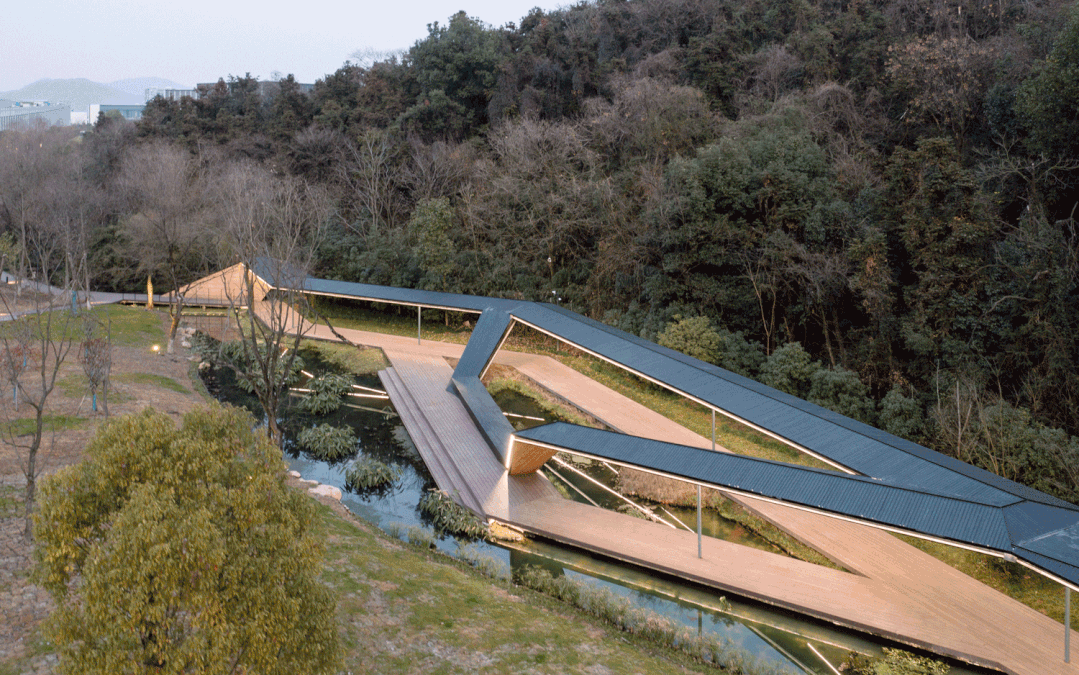
△ Floating Cornice on the Brook on the east side and the Cloud Corridor in the Valley of Music on the west side
There is a height
difference of 1 to 4 meters on the east and west sides of the original site of
Cloud Corridor in the Valley of Music, and the outer side is the campus and the
urban roadway. Compared with the monotonous retaining wall, the semi-arch wind and
rain corridor cantilevered continuously not only eliminates the interference of
traffic noise, but also poetically builds a traffic space to overlook the
distant scenery of mountains and shelter the wind and rain. The roof is then
covered with soil to blend into the landscape, softening the eastern boundary
of the campus. The micro-renewal design
implemented by line+ preserves the original spatial design relationships and
landscape texture replaces the original landscape plants by a cherry grove
consist of 33 early cherry trees.

△ 双廊剖面
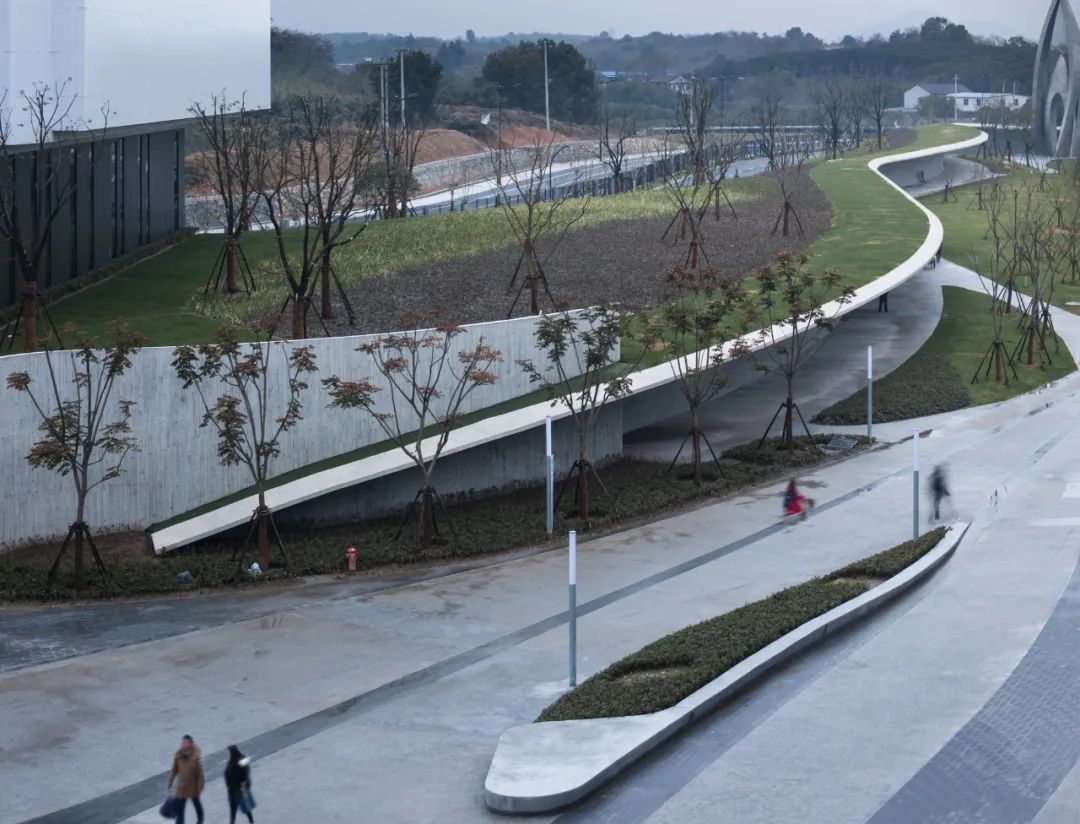
△ 柔化校园东侧边界的音谷云廊
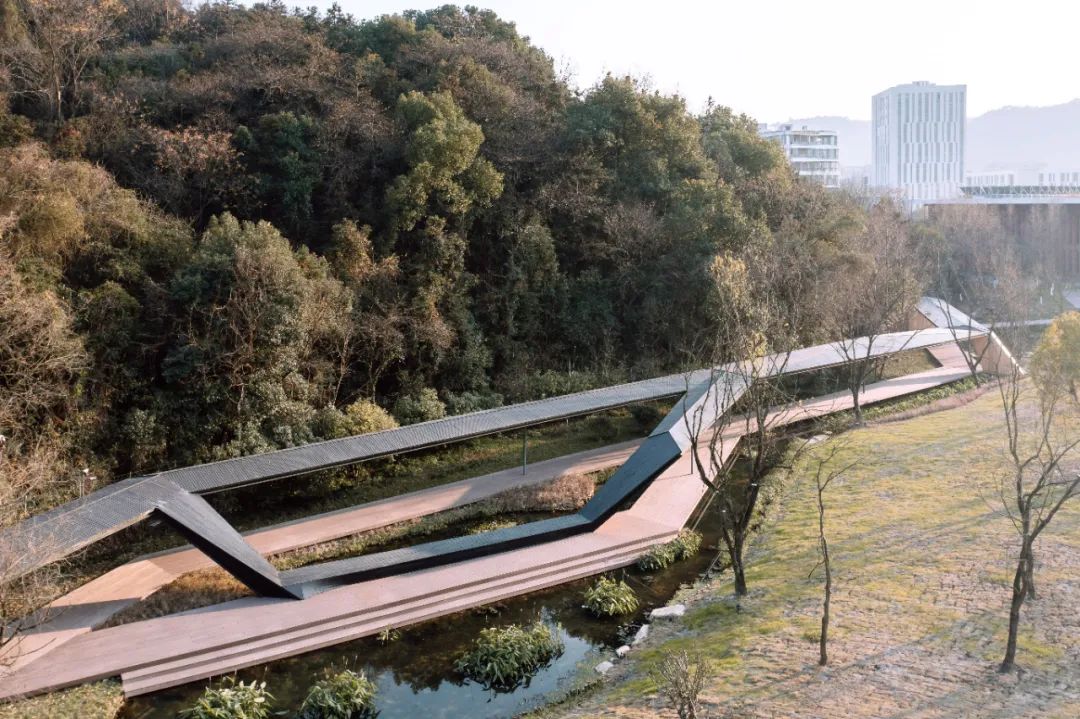
Looking west along
the Cloud Corridor in the Valley of Music, there is Wangjiang Mountain. At its
feet, the Floating Cornice on the Brook along the mountain edge, zigzagging
forward across the Brook, compound by the spatial elements of "Plank,
Corridors, Cornice, Bridge", and integrating the behavioral scenes carried
by walking along the mountain, paly with water, walking along the brook and
winding paths, creating a multiple and composite spatial experience path.


Plank: In order to avoid the disturbance to the original environment of the site, the folding corridor is elevated above the brook, as close to the water as possible, avoiding the native trees in each folding, and fitting the trend of the mountain.
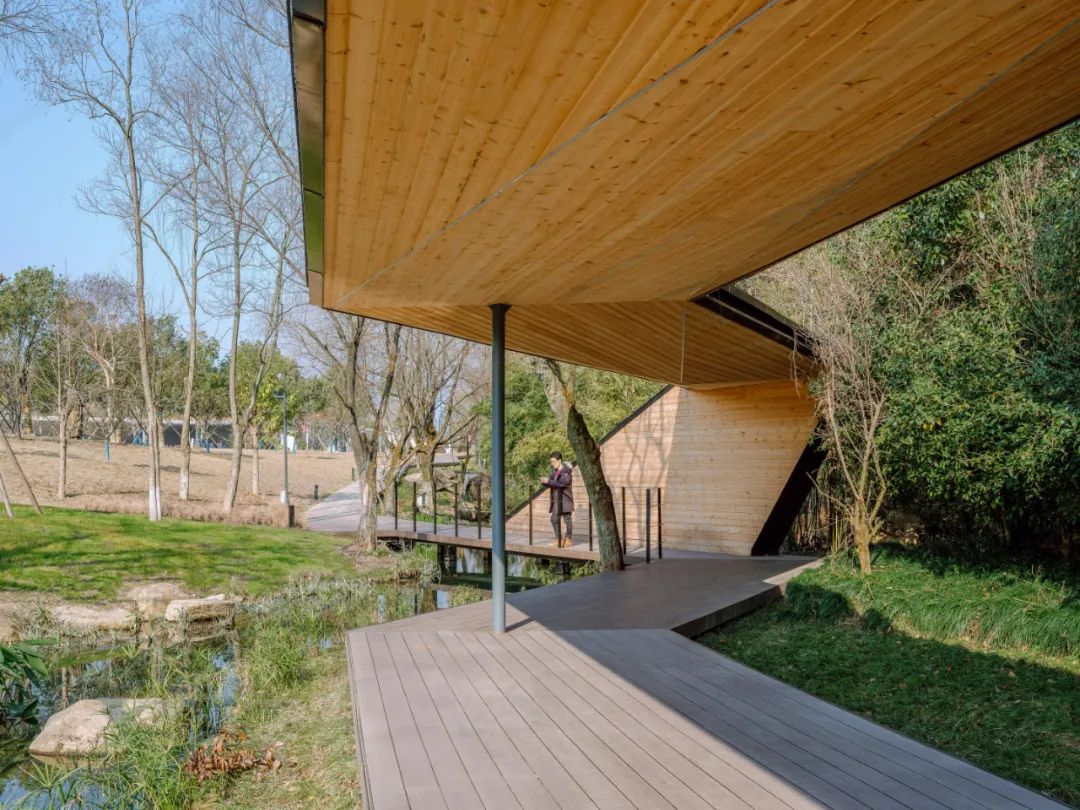
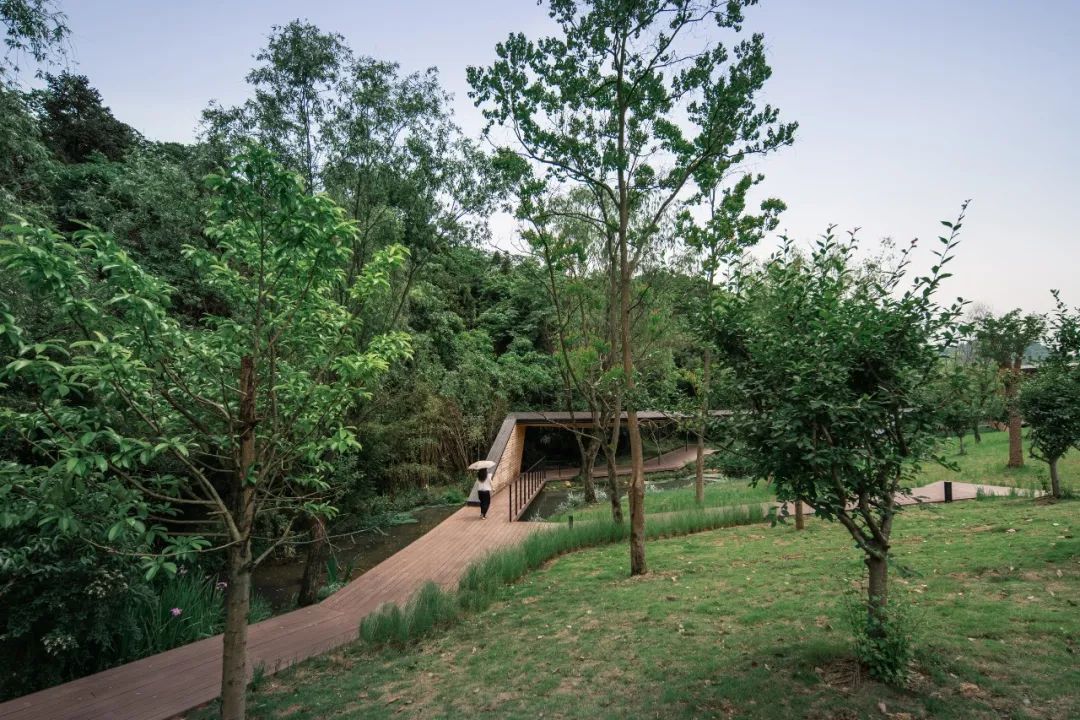
Corridor: roof float
on and columns stand on the plank to form a corridor, which bends in accordance
with the trend of the mountain edge and the bank, folds middle part into the
brook for pedestrians take several steps to sit next the brook. Corridor
integrate the functions of sitting, watching and strolling, which creating a
shared leisure place.
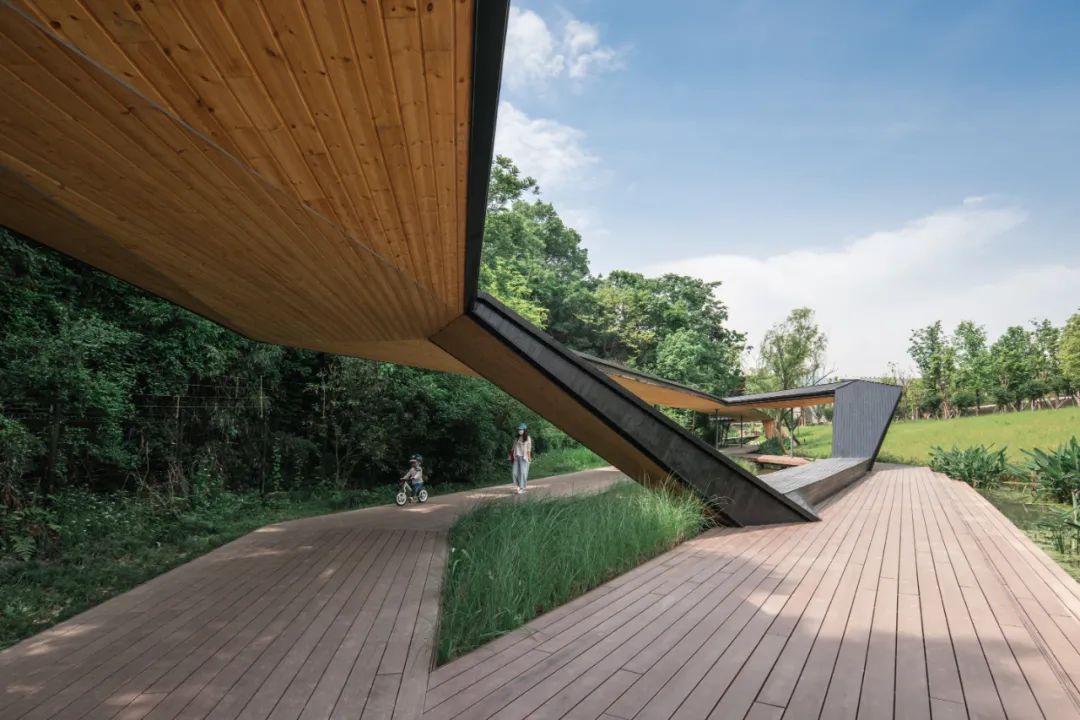
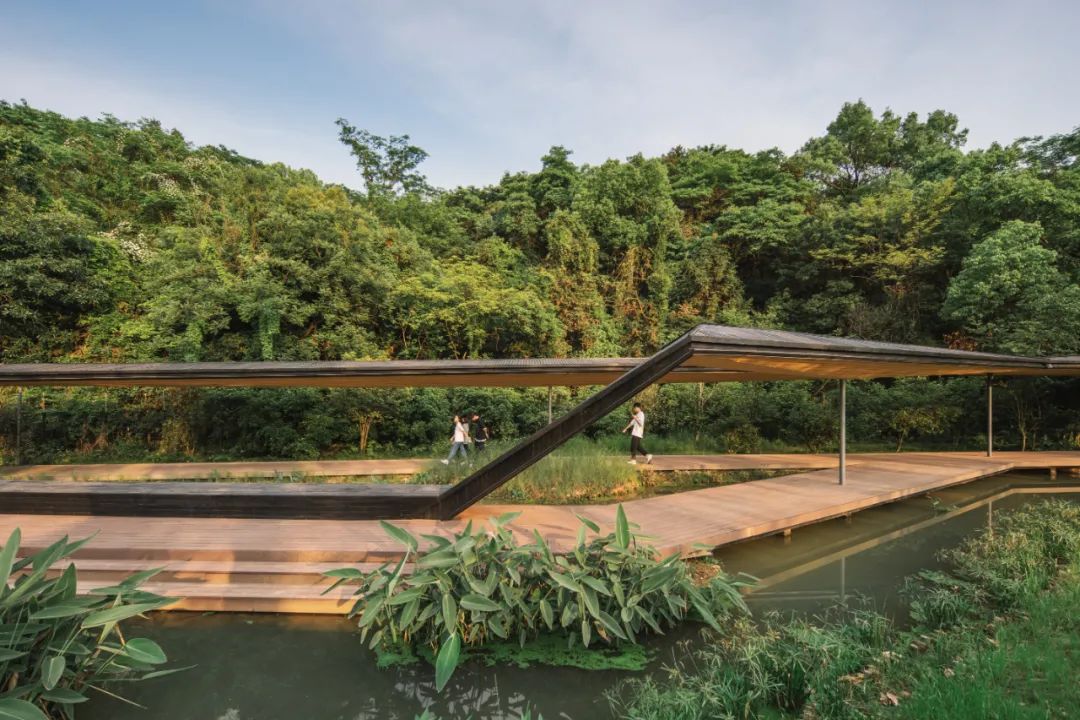
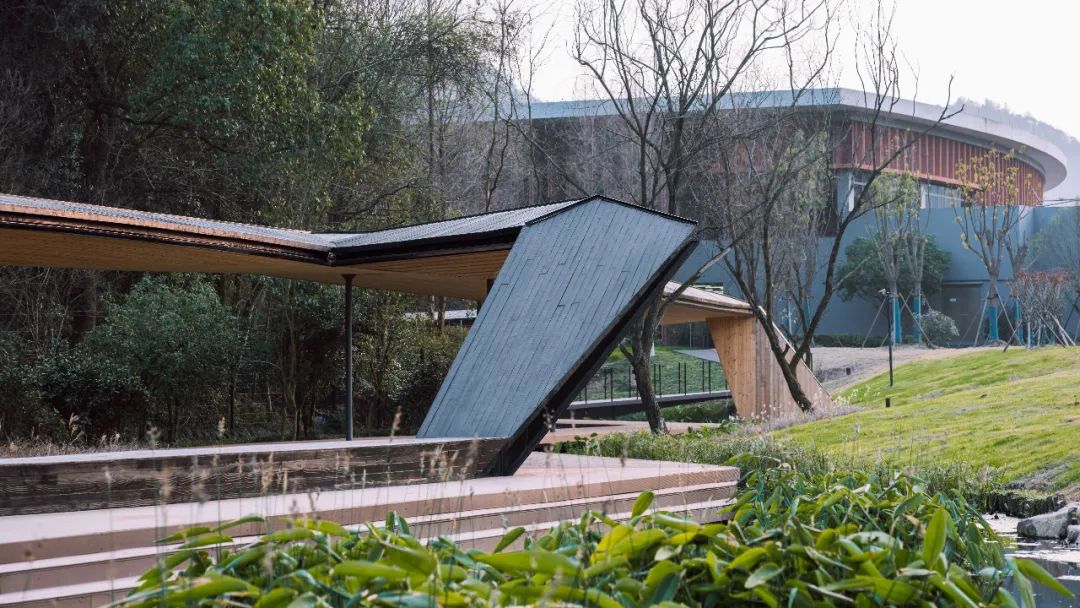
△ Pedestrians take several steps to sit next the brook
Cornice: simplify
the traditional sloped roof ridge and eaves, smooth the slope difference of
double-sloped roof, so that Cornice appears light and unobtrusive. The Cornice
are twisted and folded on the Plank to form a bench for lounging and a buttress
that defines the beginning and the ends.
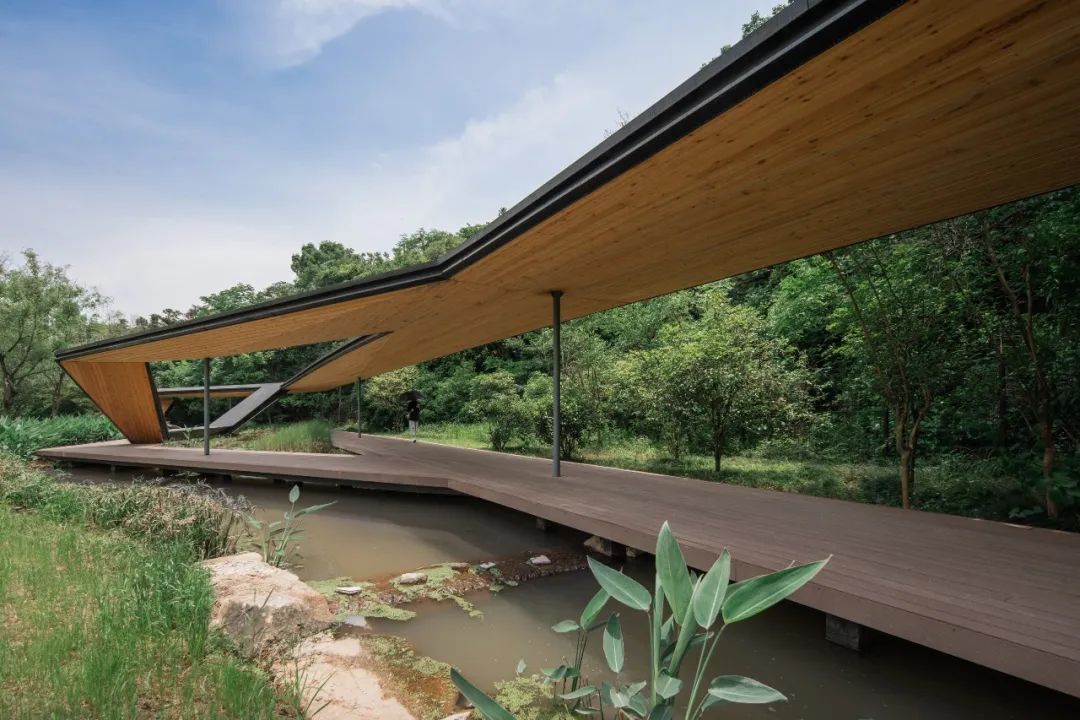
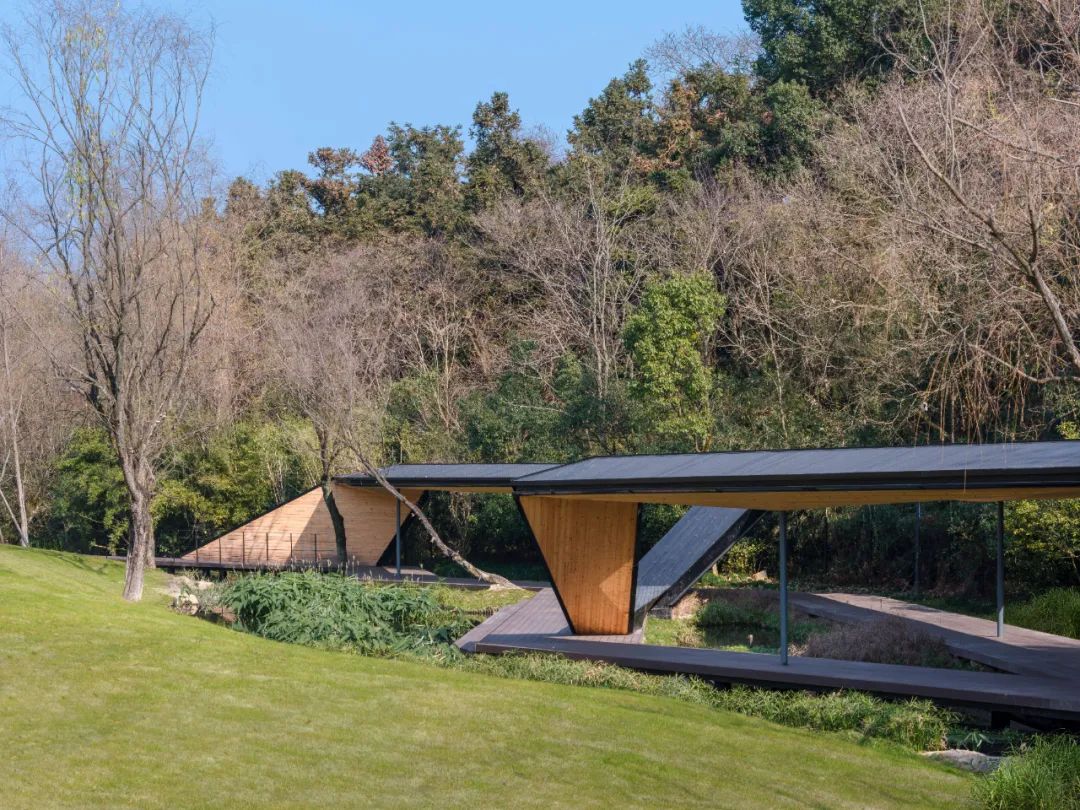
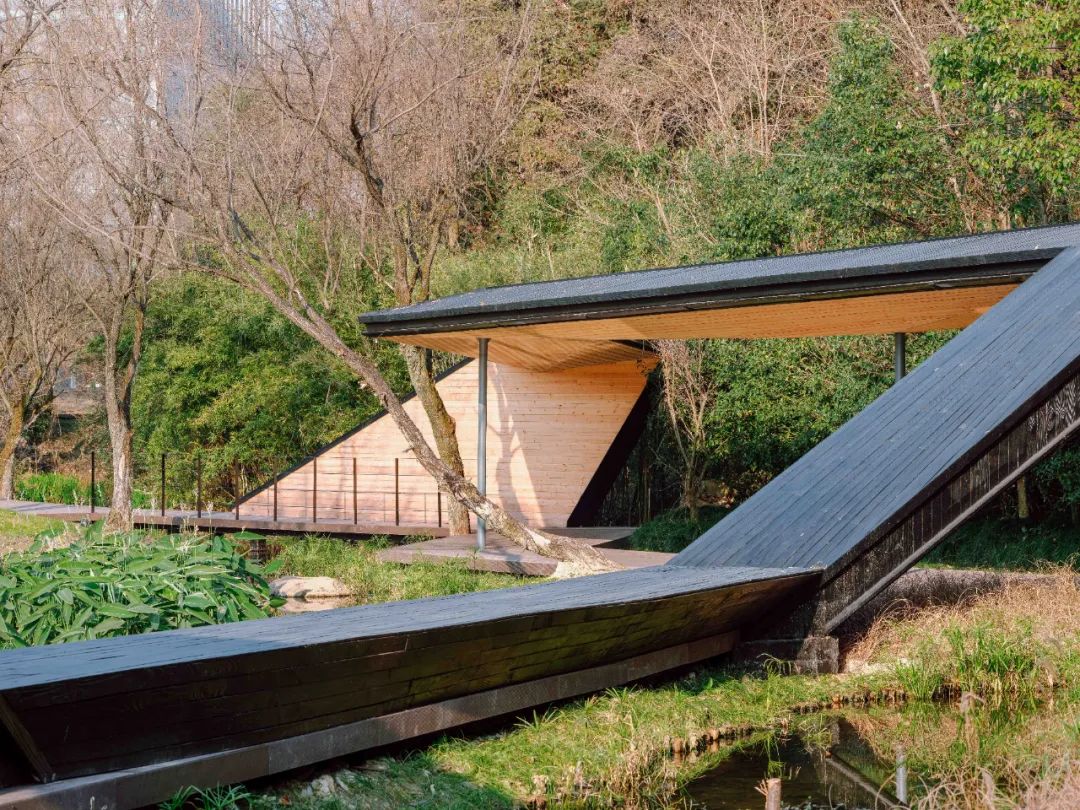
△ The Cornice are twisted and folded on the Plank to form a bench for lounging and a buttress that defines the beginning and the ends.
Bridge: The brook forms a pond in front of the campus canteen. A steel bridge with a slight tilt is set up on the pond, cantilevering unilaterally and entering the slope lightly.
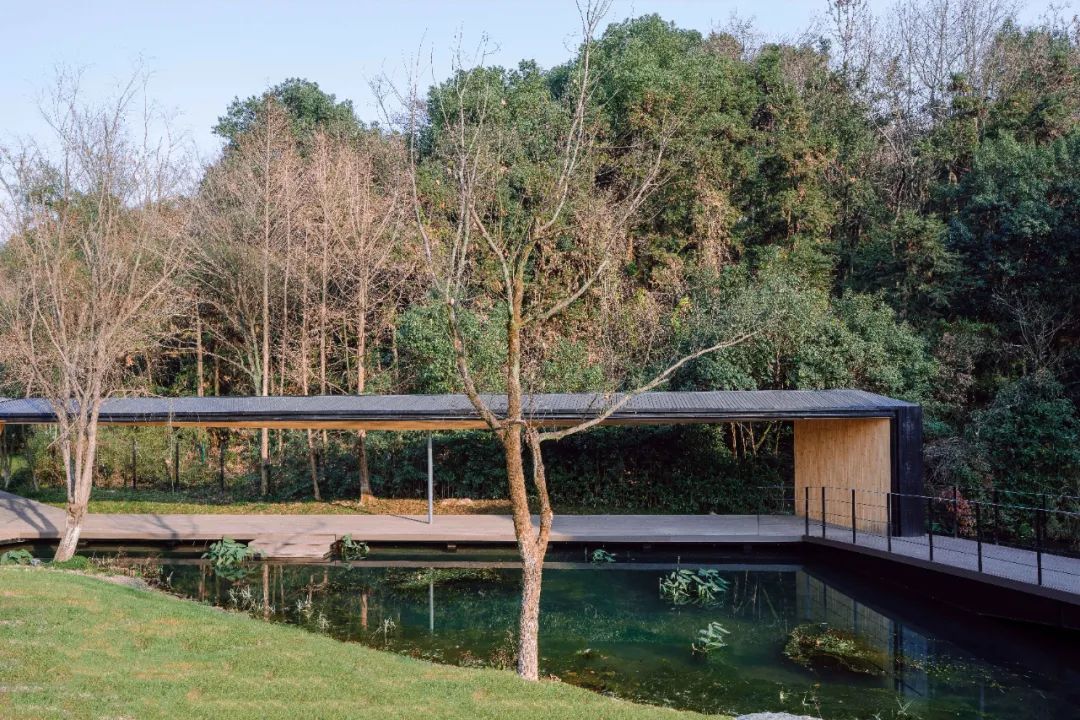
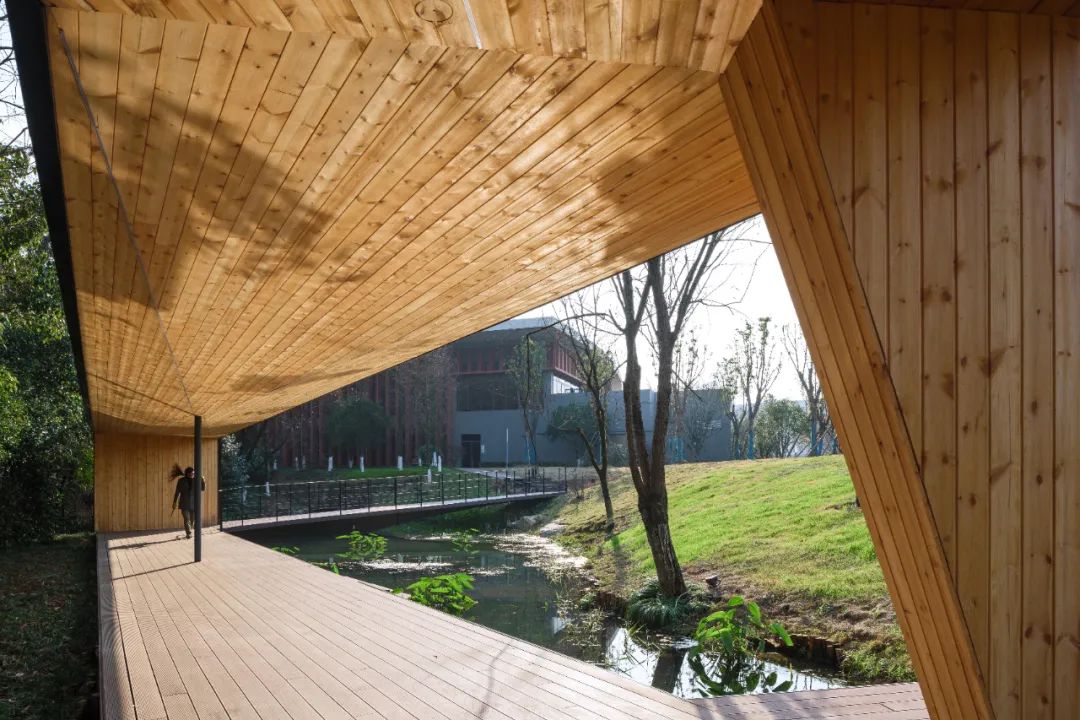
△ A steel bridge with a slight tilt is set up on the pond, cantilevering unilaterally and entering the slope lightly
In contrast to Cloud
Corridor in the Valley of Music with continuous curvature, by using fold lines
with clear nodes and morphological translation of various spatial elements in
garden space, Floating Cornice on the Brook constructs three-dimensional
composite forms in horizontal and vertical directions, and builds a
self-consistent system that compounds behavior and scene.
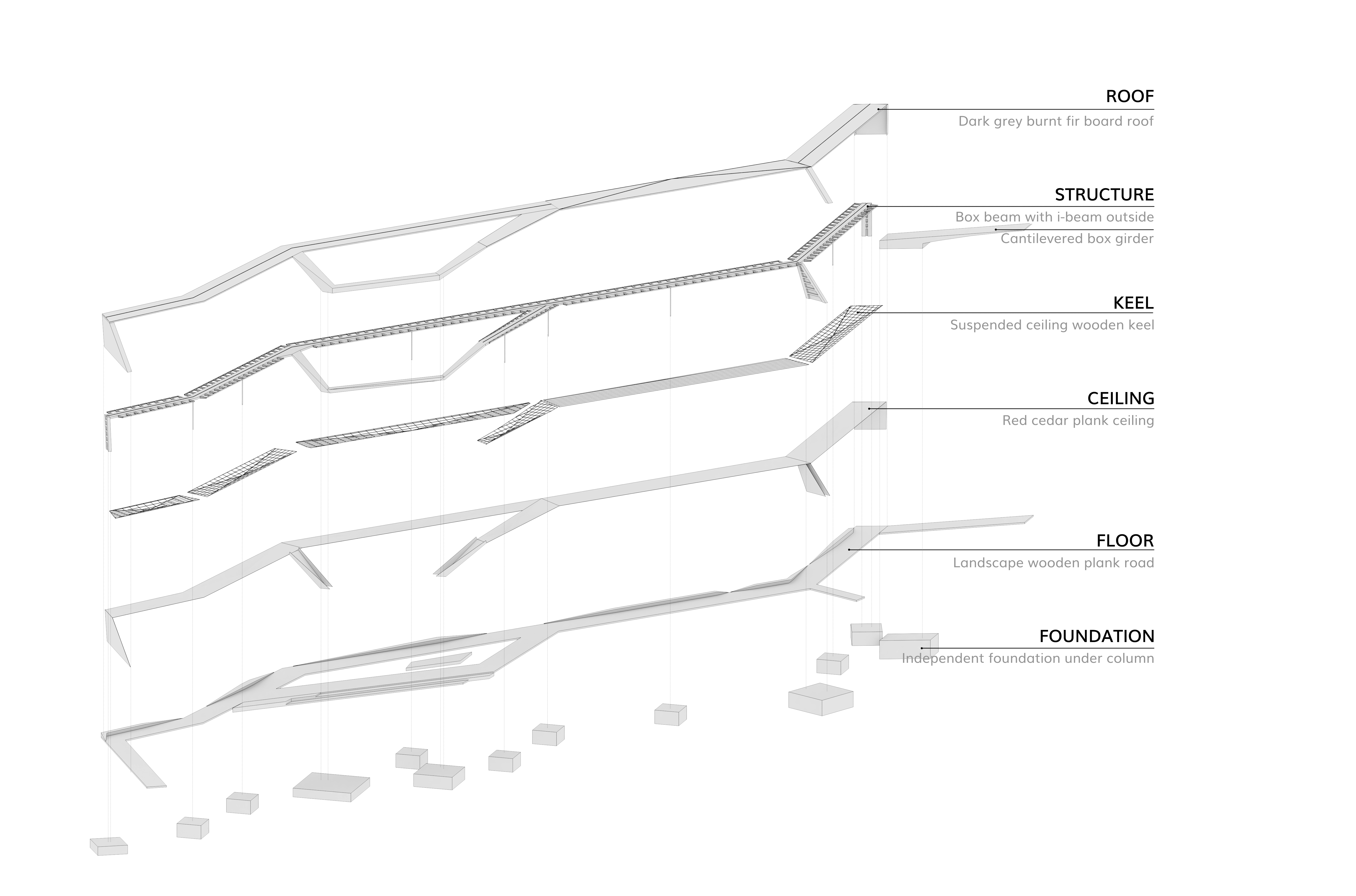
△ Material and structural analysis
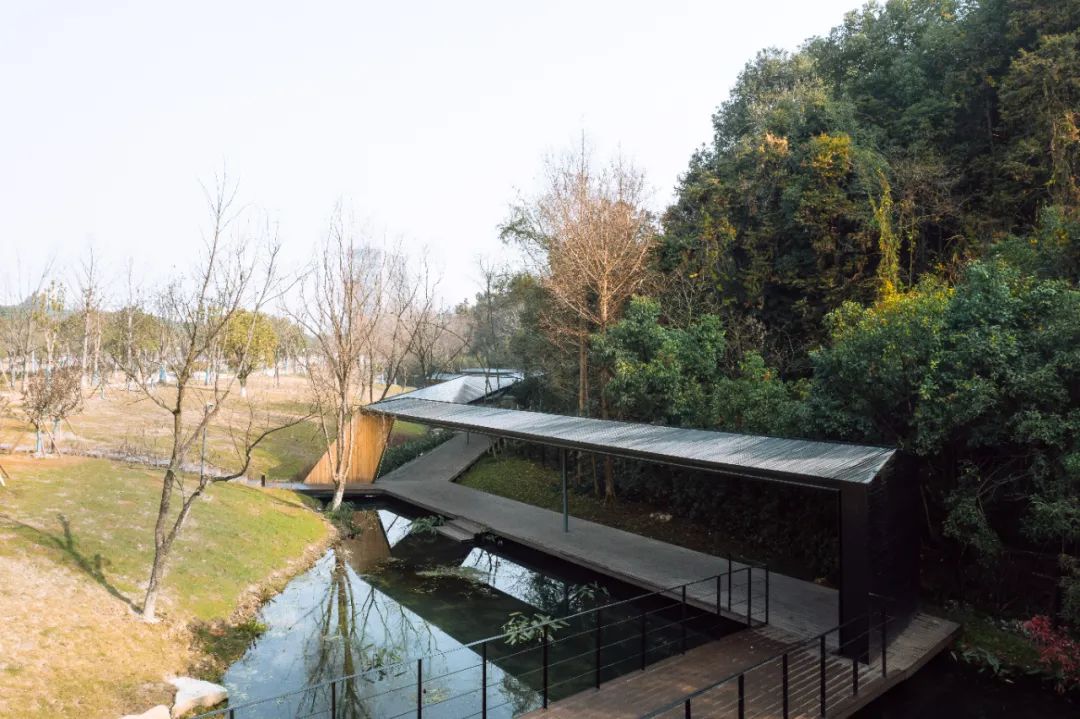
△ Floating Cornice on the Brook builds a self-consistent system that compounds behavior and scene.
| 2.2 Structural Dialogue |
Void and Solid / Hardness with Softnes

The roof structure of Floating Cornice on the Brook is a box-shaped beam with an I-shaped beam and the roof is an abstract form of double slope and four-corner polygonal roof. Corresponding to the four corners polygonal roof, the ceiling forms an inverted pyramid. All the fulcrum points converge at the apex of the pyramid, so that the roof which is north-south length of 113 meters is supported on the ground by only five slender steel columns. Vertical structural members are thus minimized use.

△ Structural analysis
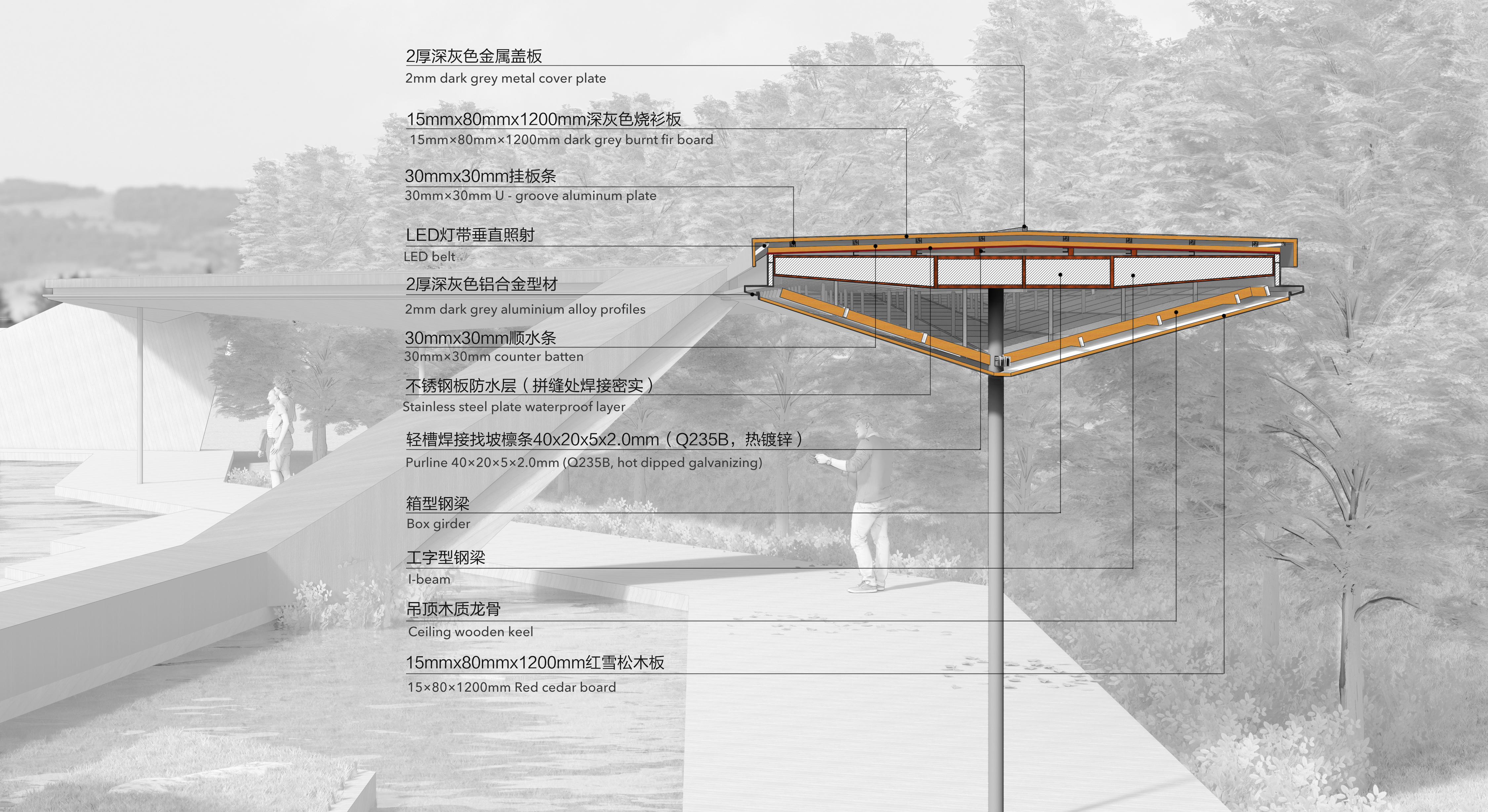
△ Constructed node analysis
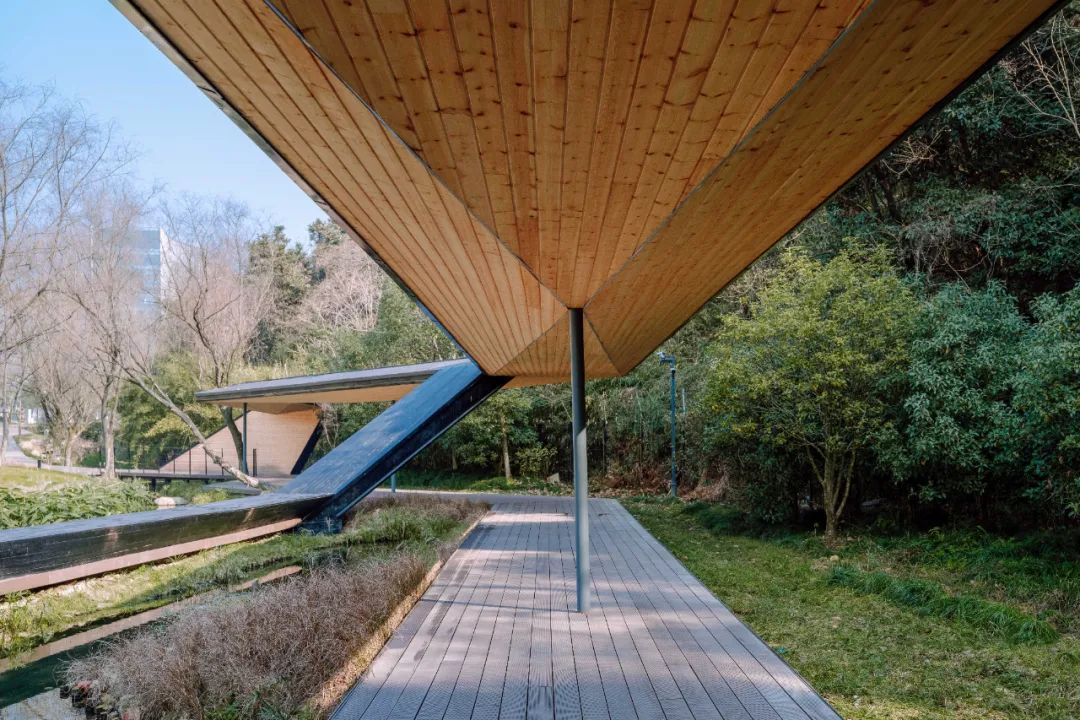
△ Corresponding to the four corners polygonal roof, the ceiling forms an inverted pyramid, and all the fulcrum points converge at the apex of the pyramid.
Viewed from the far
side of Cloud Corridor in the Valley of Music, the steel column of Floating
Cornice on the Brook looks like a tree trunk. The horizontal member Cornice
thus becomes the visual focus, presenting the effect of Cornice overhanging
over the Brook, and realizing the integration with the surrounding landscape.
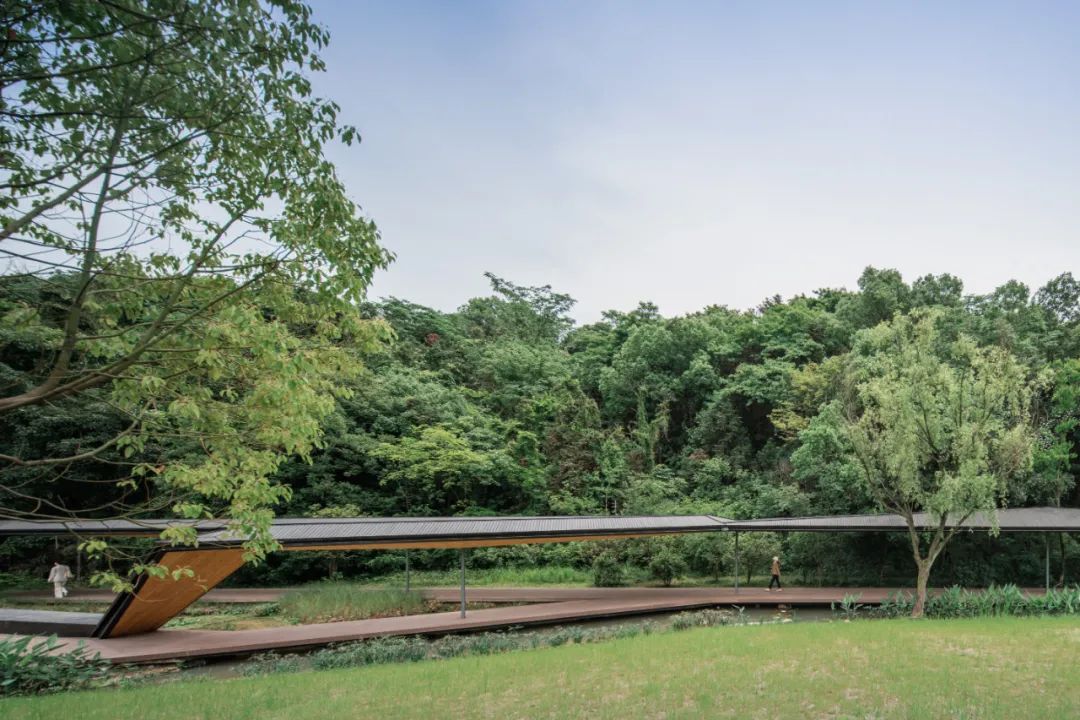

△ Presenting the effect of Cornice overhanging over the Brook, and realizing the integration with the surrounding landscape
Wood seams are set
aside at the junction of the block surfaces of the four-pyramid pine ceiling
along the Floating Cornice on the Brook, and LED lamp bars are inlaid to
strengthen the geometric relationship of the block surfaces and form a smooth
and simple light effect.

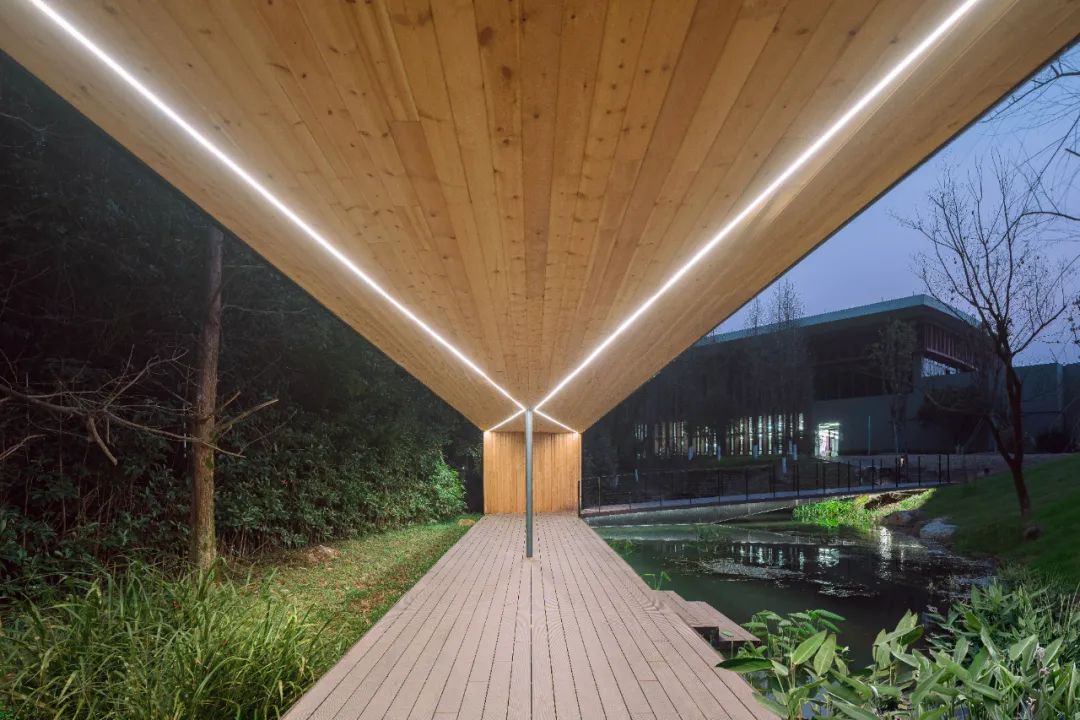

△ LED lamp bars are inlaid to strengthen the geometric relationship of the block surfaces
At night, the lamp
belt is lit, and the ceiling and column are like umbrella frames. Lights on the
roof outline the path of people.
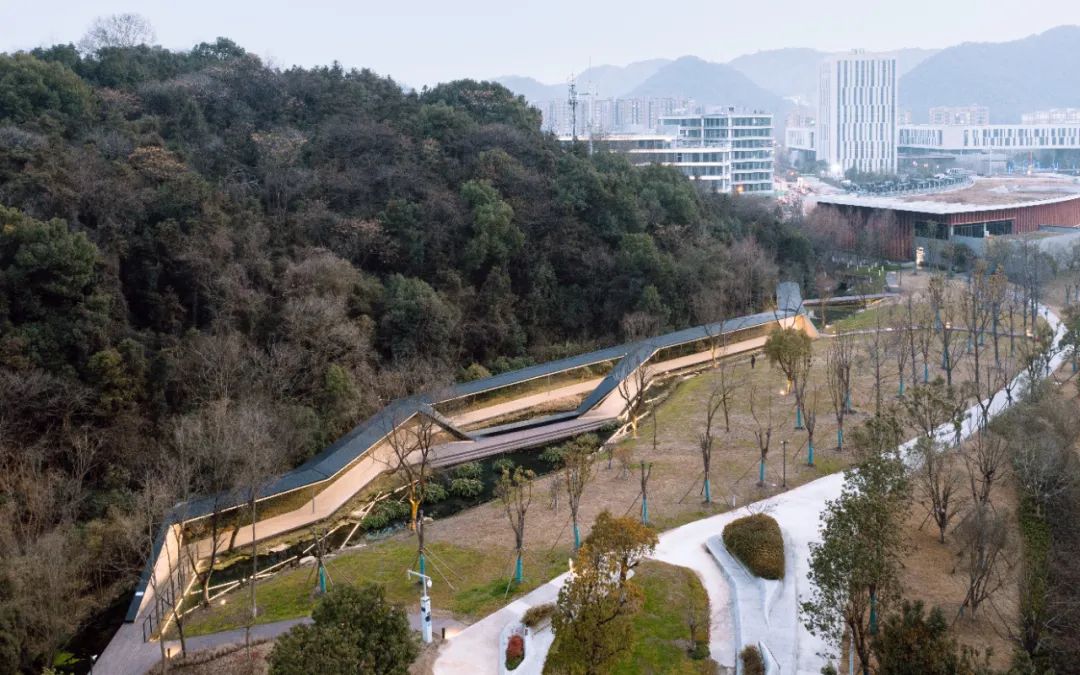
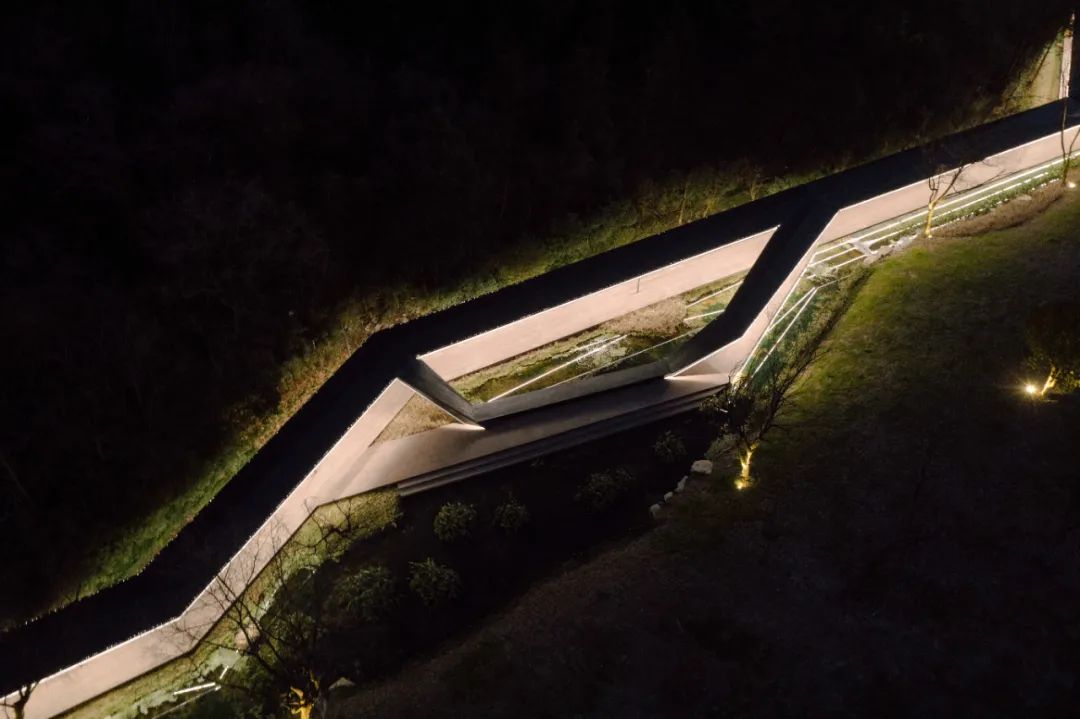
In contrast to the
void presented by integration with the surrounding landscape, Cloud Corridor in
the Valley of Music uses solid materials as a screen and satisfies the
functional premise of sound blocking and soil retaining. Meanwhile, following
the vertical height difference on both sides, the construction is adapted to
local conditions. The special-shaped fair-face concrete is designed with
multiple controlled curvature segments and 600 sections with acoustic gain
performance to form a soft and continuous single-arm cantilever structure by
setting out each half meter in sections.
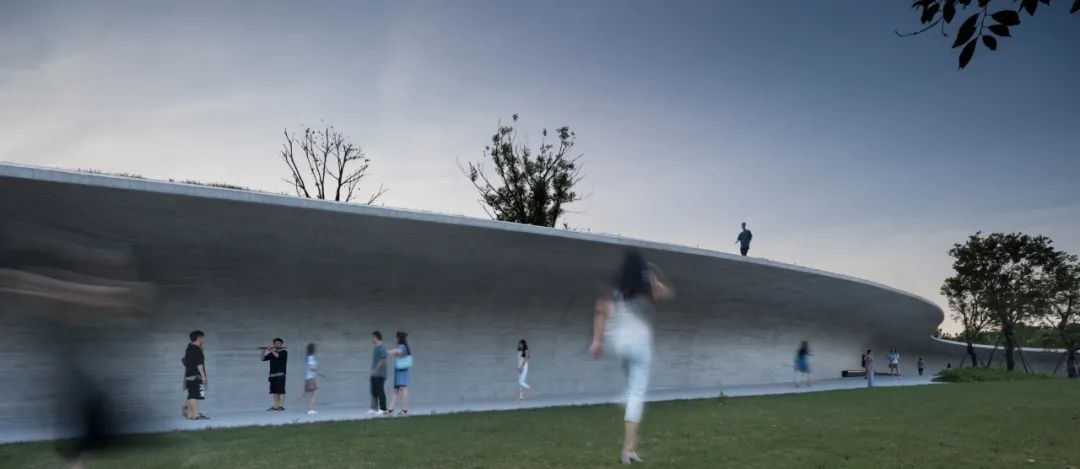
△ Cloud Corridor in the Valley of Music uses solid materials as a screen and satisfies the functional premise of sound blocking and soil retaining
The operation and
maintenance of the campus have become normal after years of use. In order to
reduce the interference of construction behavior to the campus teachers and
students, the construction of the Floating Cornice on the Brook was carried out
in summer vacation. During the construction process, the main components of the
steel structure were prefabricated in the factory and then transported to the
site in sections for assembly, which has shortened the construction period and
ensured better accuracy. Clear fold line joints and segmental assembled
prefabricated steel structure make Floating Cornice on the Brook show a state
of hardness, and forms a void and solid comparison as well as couple hardness
with softness.

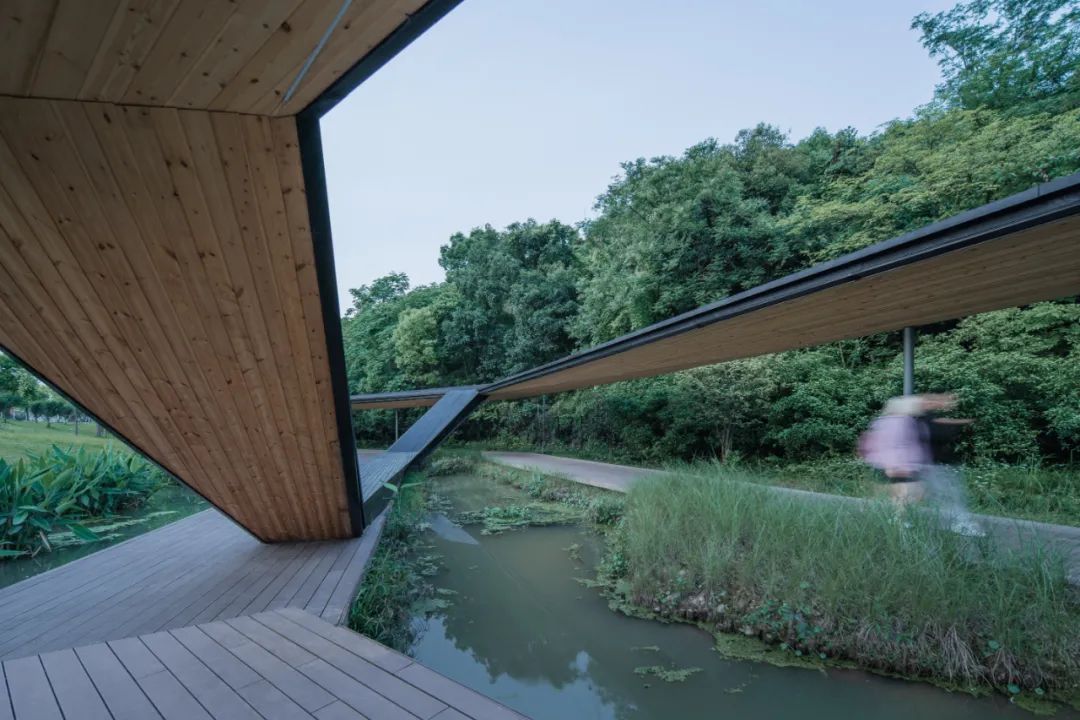
| 2.3 Mapping of Materials |
Warm
and Cold/Outside and Inside
In terms of
materials, the Cloud Corridor in the Valley of Music of fair-faced concrete
presents stronger spatial tension. In contrast, because of its smaller scale
and fit to the mountain, the Floating Cornice on the Brook adopts more natural
timber to build, and the spatial is comfortable and relaxed for pedestrians.
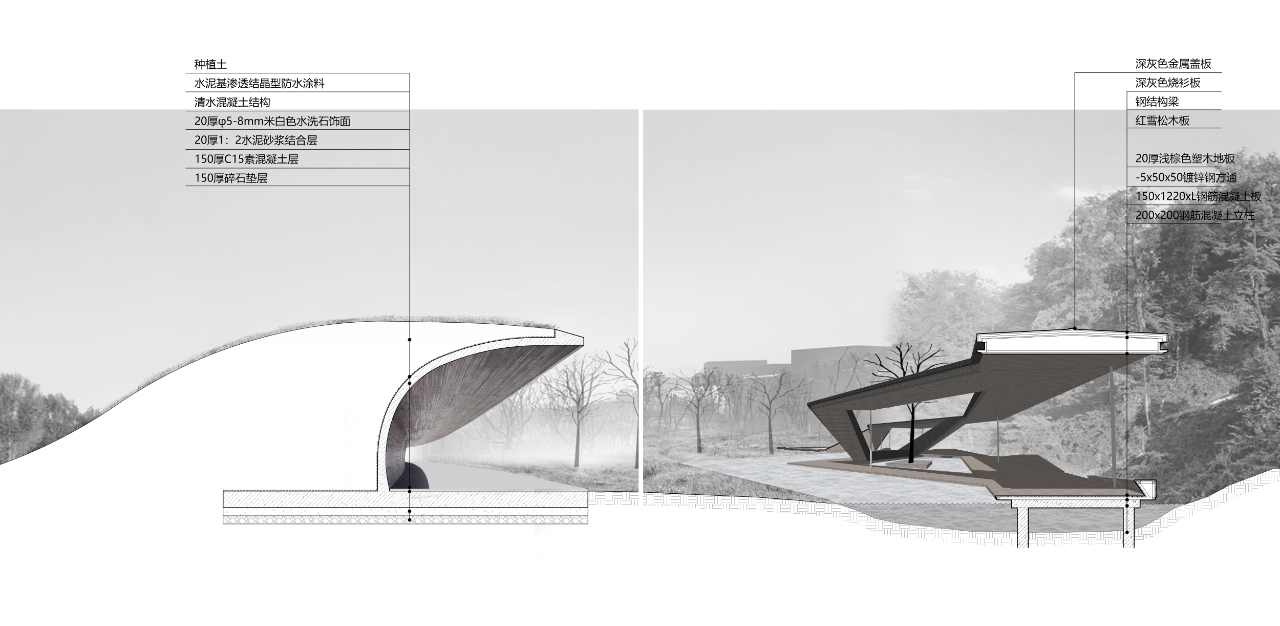
△ Material analysis of Floating Cornice on the Brook and Cloud Corridor in the Valley of Music
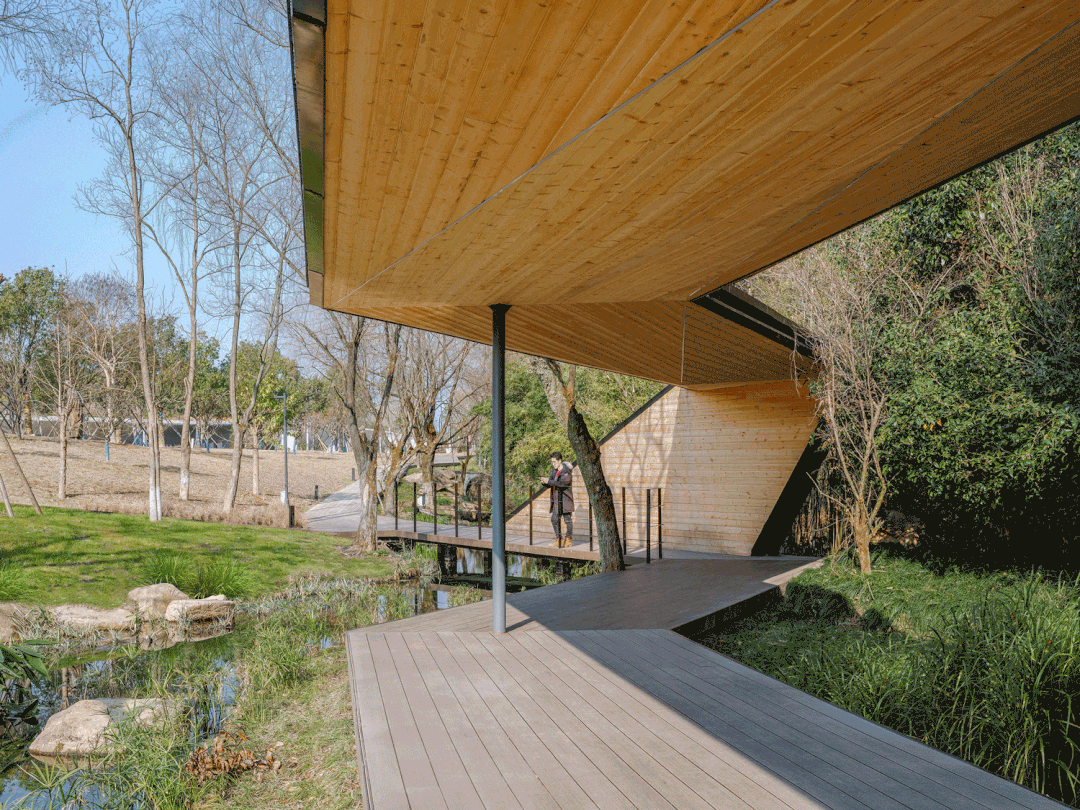
△ Wood texture is formed from the inside to the outside
In contrast to
Floating Cornice on the Brook is the implicit expression of the timber in the
inner wall of the Cloud Corridor in the Valley of Music. The formwork frame of
the flow curve and irregular structure of the supporting concrete corridor is
composed of 80mm fir board and bamboo plywood board. The timber transfer
texture refines the large screen seems as clouds and waves into a tactile
intimacy scale and shelter of rustic sense. From the outside to the inside, the
Cloud Corridor in the Valley of Music sets each other off with the real wood
grain texture of the steel wood folding corridor.

△ Concrete for cloud corridor in the valley of music and pine boards for floating cornice on the brook
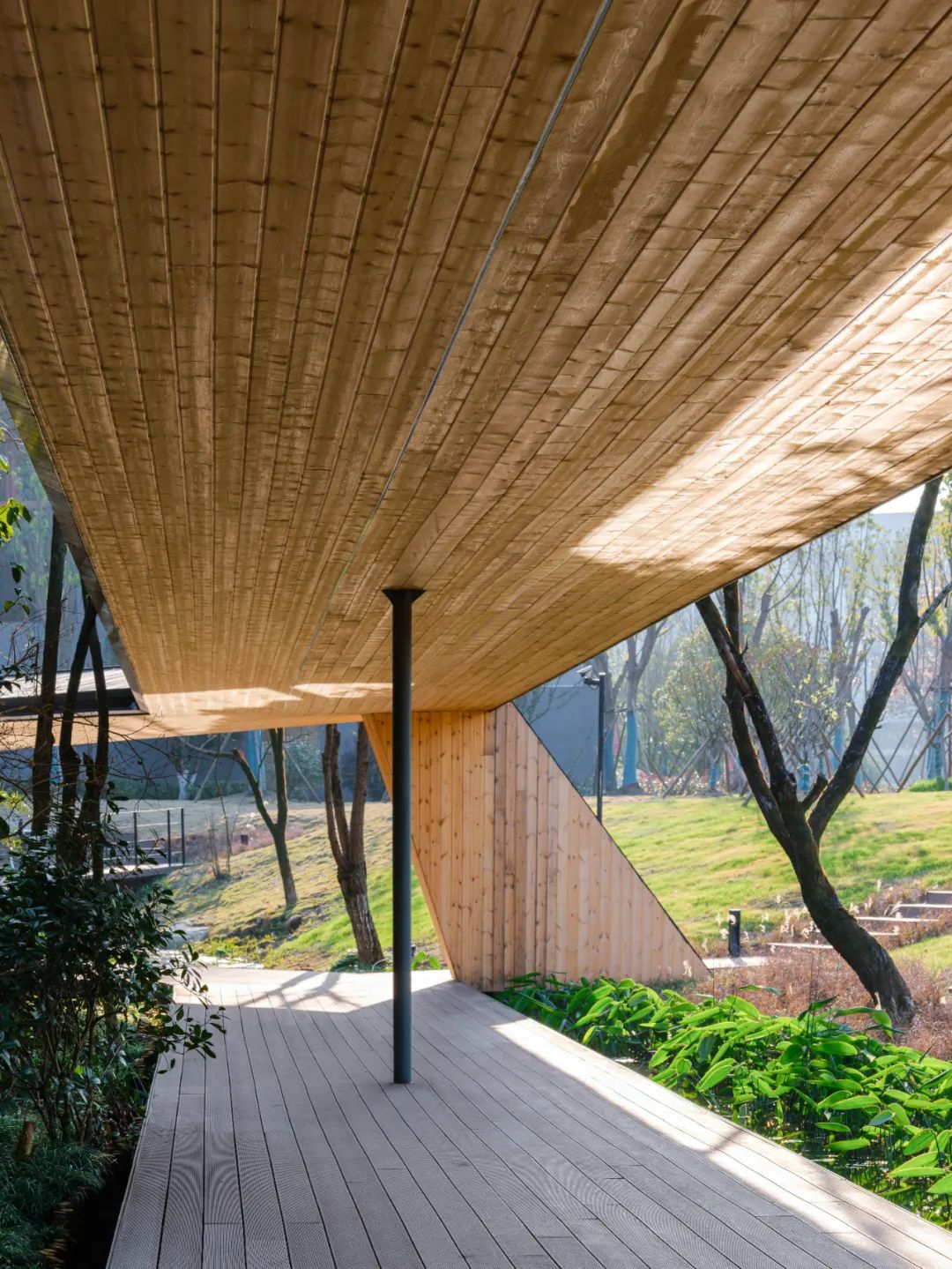
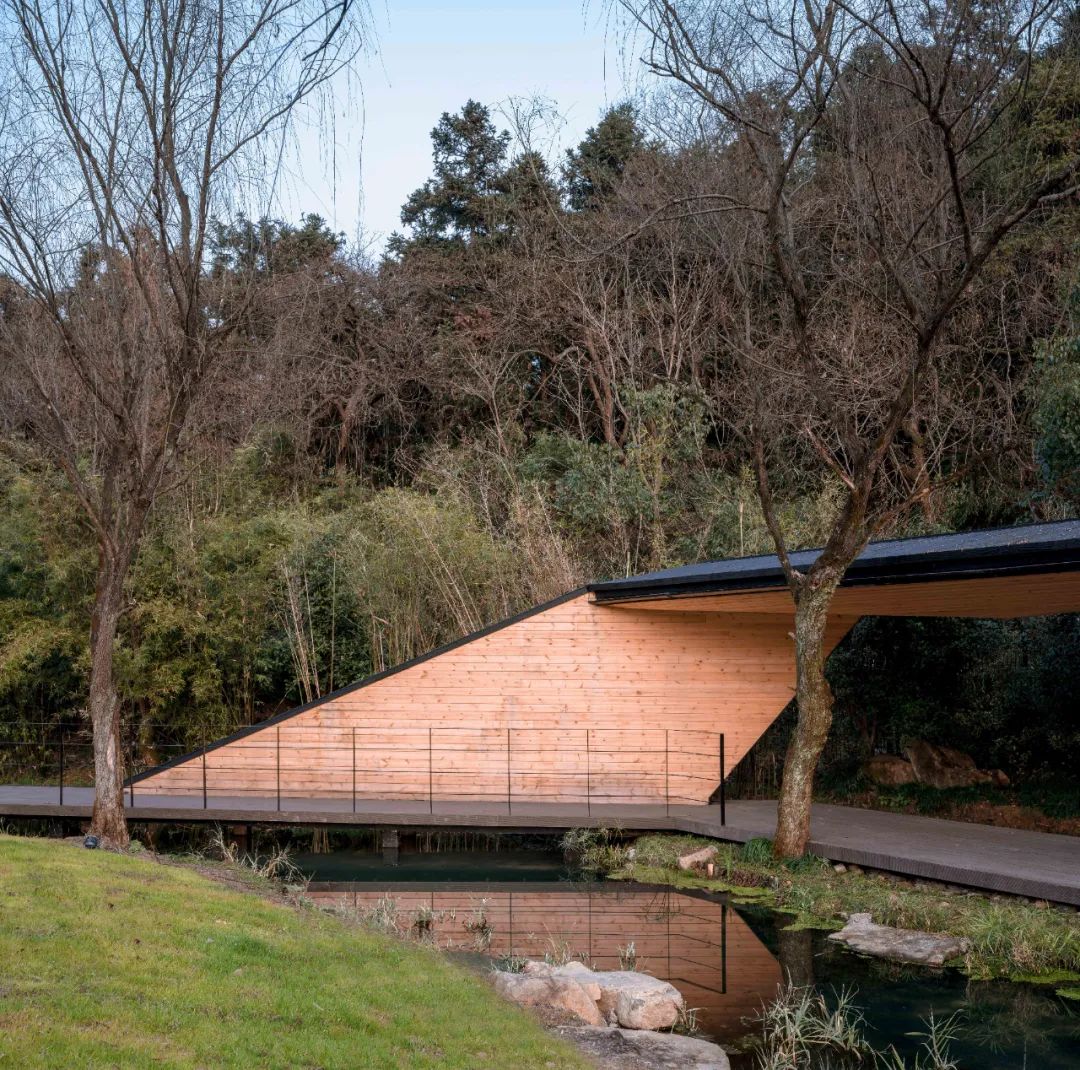
Floating Cornice on
the Brook uses wood to convey two forms of expression of a single material. The
dark burnt fir board is used for the roof covering and seats, which is
resistant to natural corrosion and hidden the folding corridor in the woods.
The ceiling and corridor buttress are made of primary red cedar wood, presenting
natural color. Inside the corridor, pedestrians are accommodated with warm
texture.
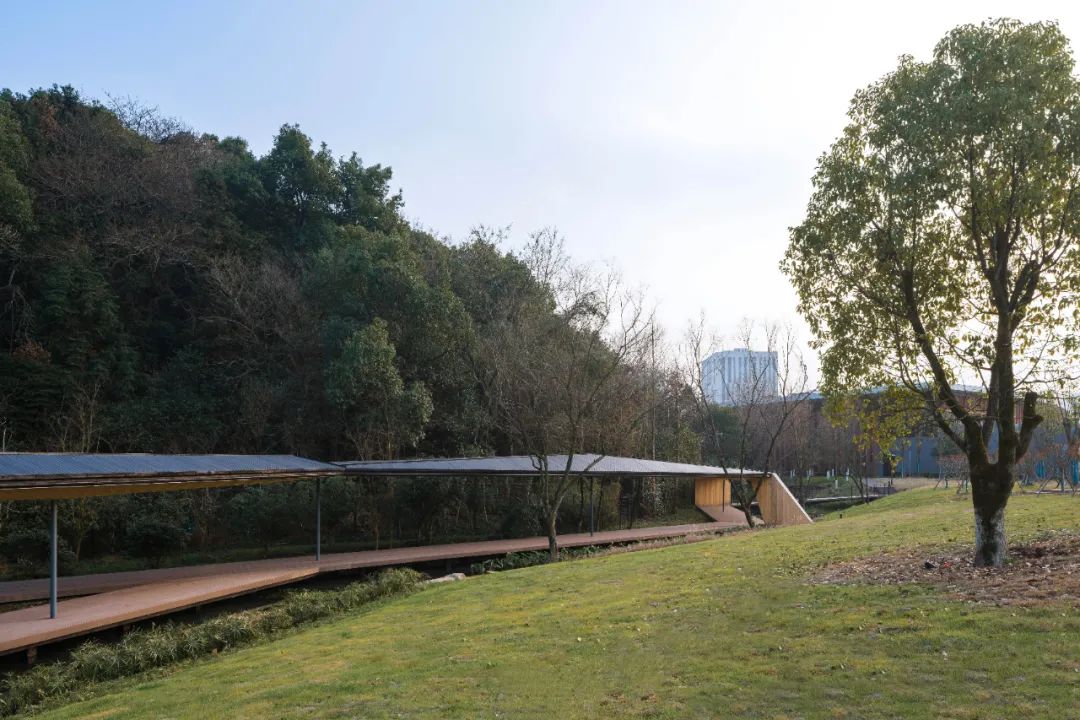
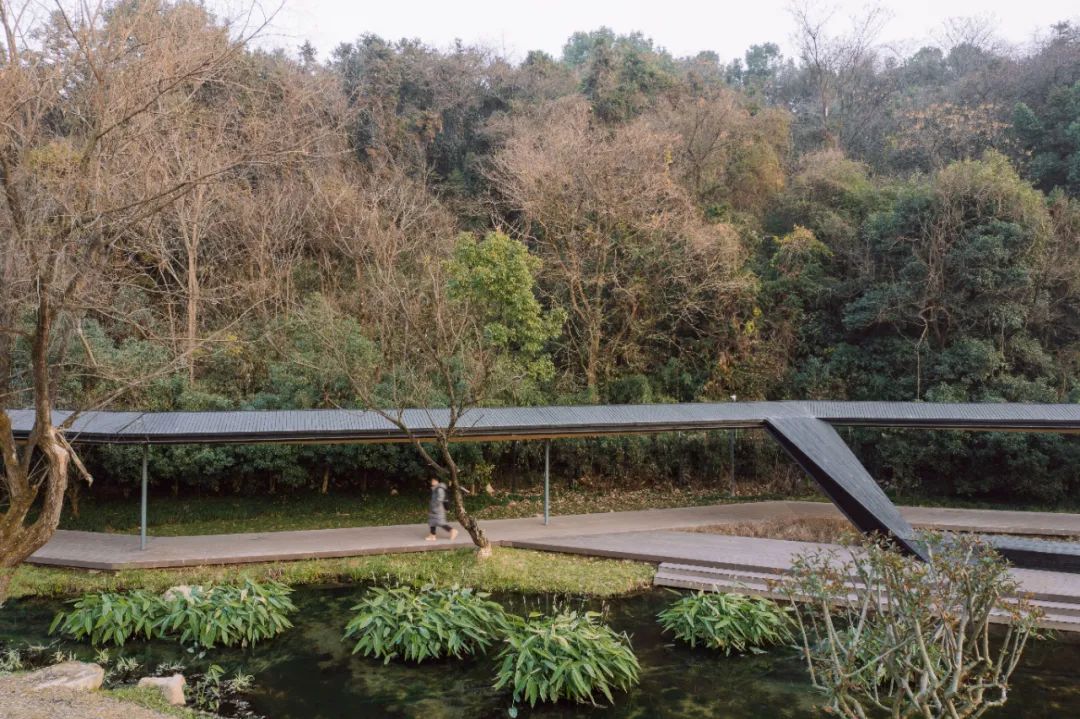
As the sun sets, the
primary red board cedar ceiling reflects the light and shadow of the brook. At
this time, the folding corridor is a comfortable and relaxed leisure space,
where people lean on the fence to watch the fish, pick up the steps and sit and
leisurely stroll. Floating Cornice on the Brook are extended in a friendly
manner, guiding people inside and outside the school to participate in artistic
activities.
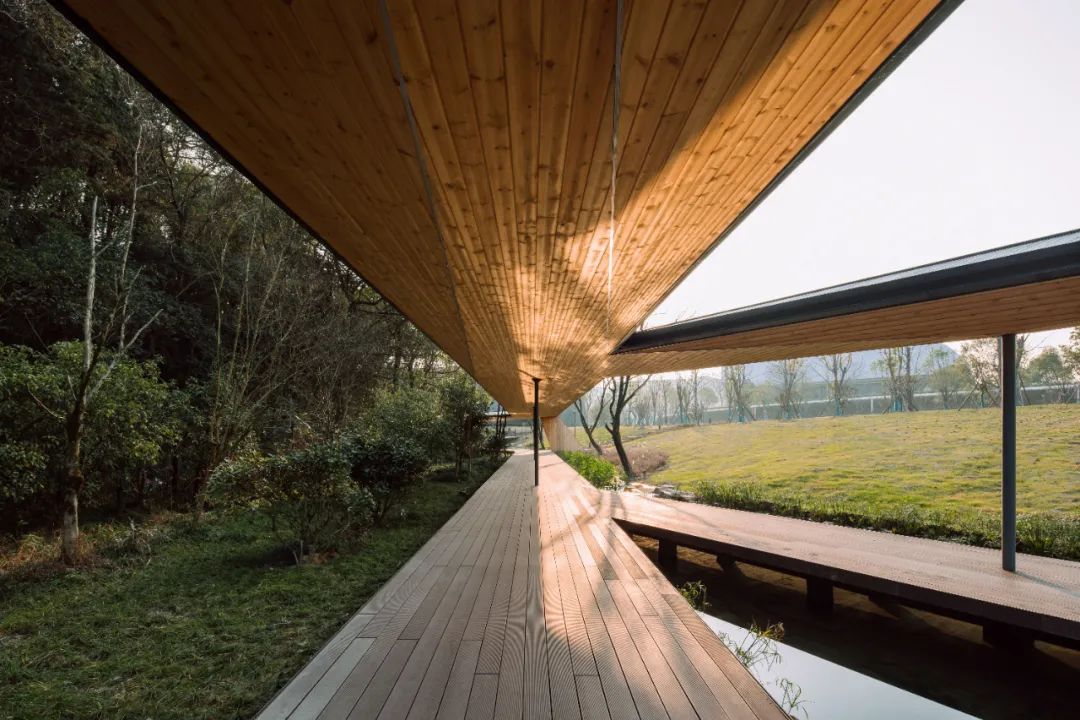
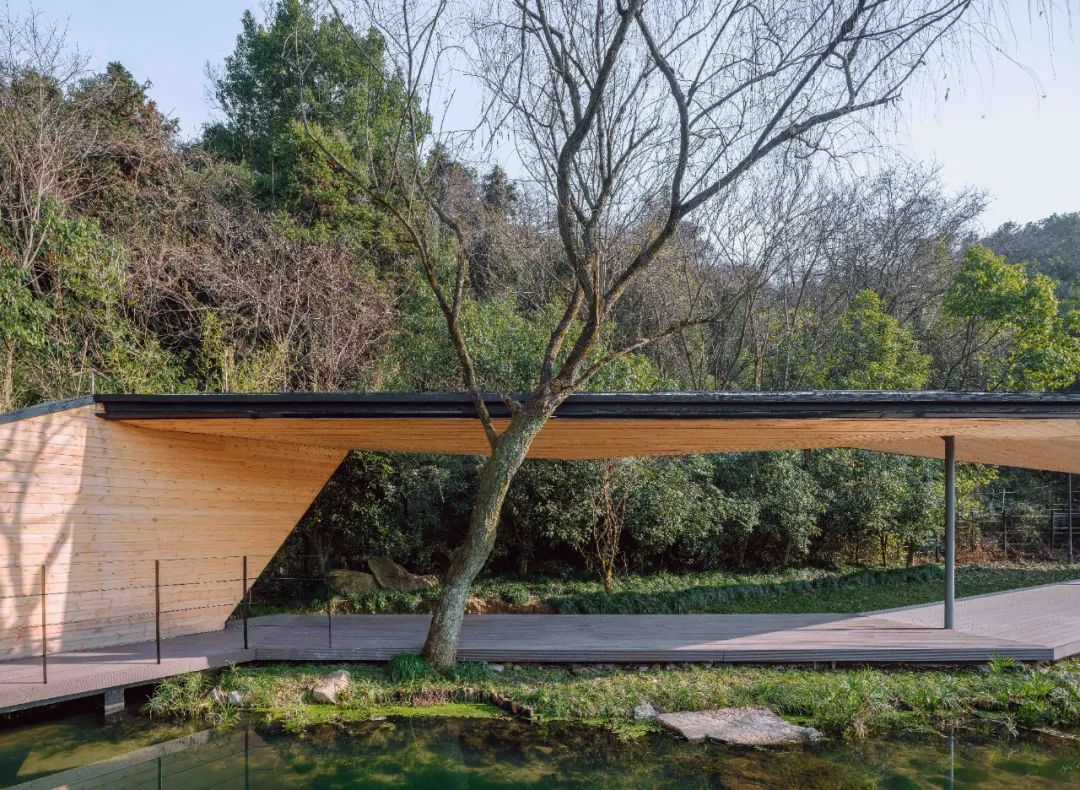
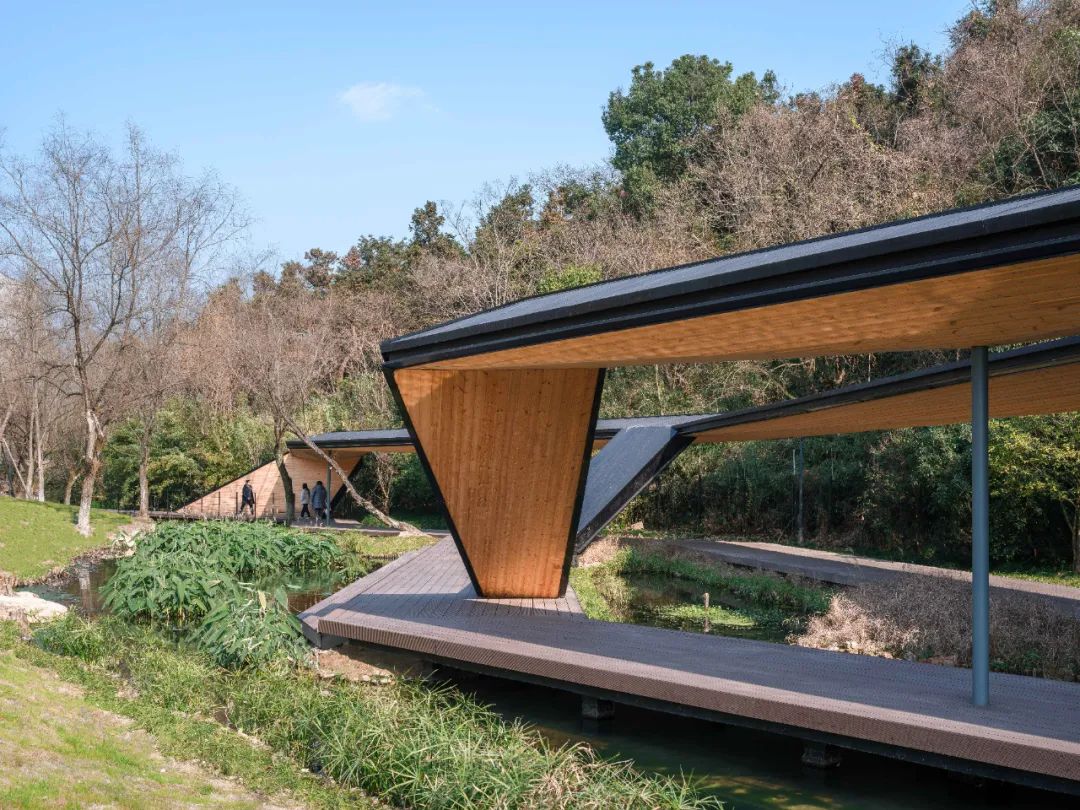
| 03 |
Eco-Friendly: Sponge Landscapes
As an important node
of the ecological axis of the campus, Floating Cornice on the Brook, with the
concept of rain gardens and minimal intervention on the site, the native campus
water system, trees and grasses are preserved and incorporated into the design
of the space, trying to build a campus sponge landscape that combines
ecological sustainability with landscape art and behavior participation.
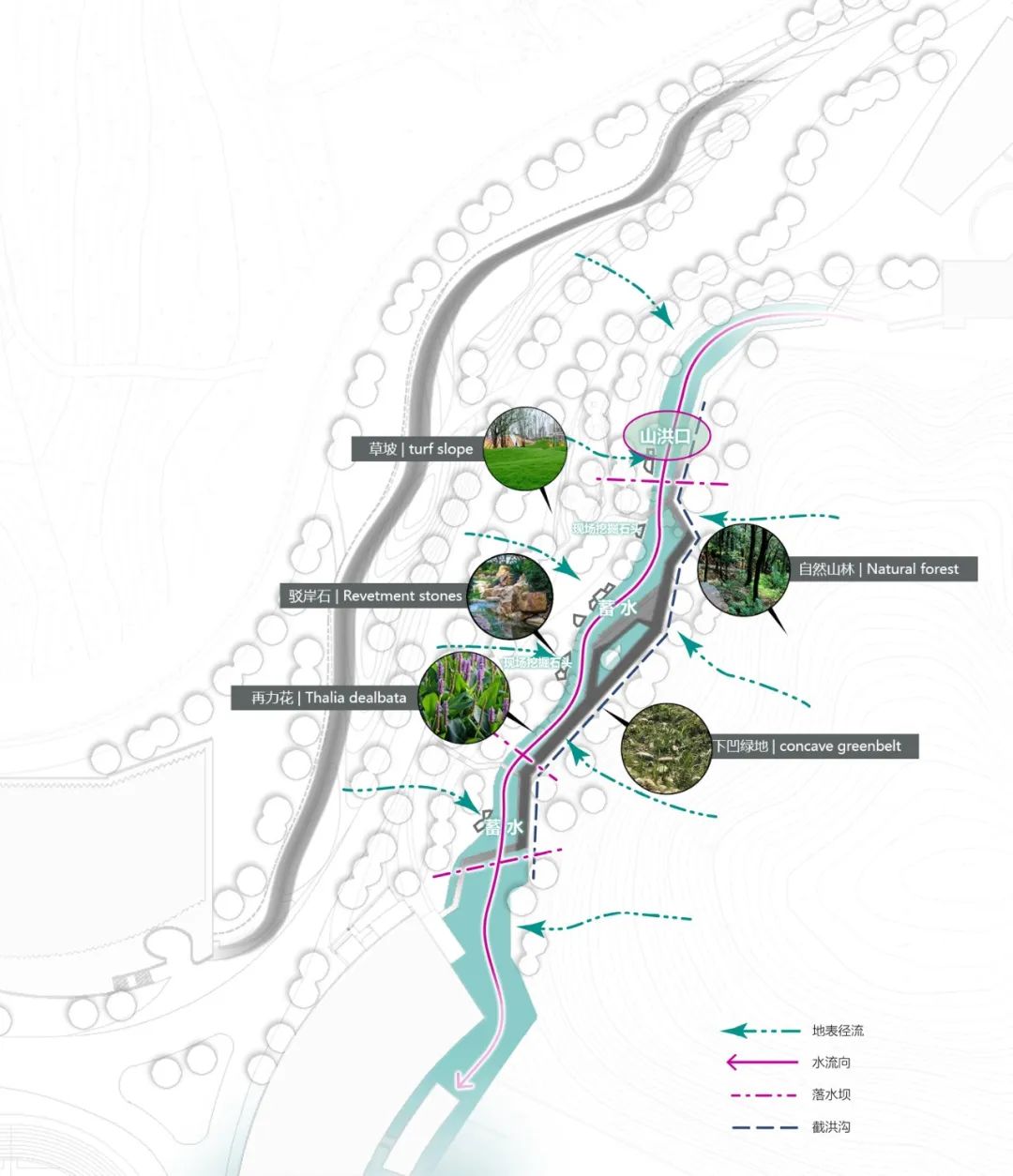
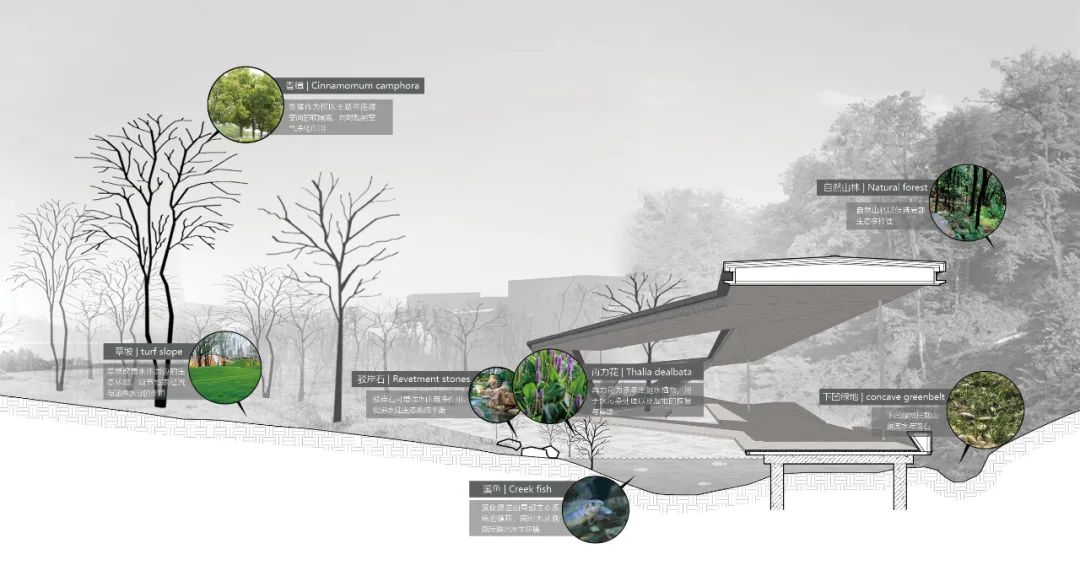
△ Surface runoff into the brook
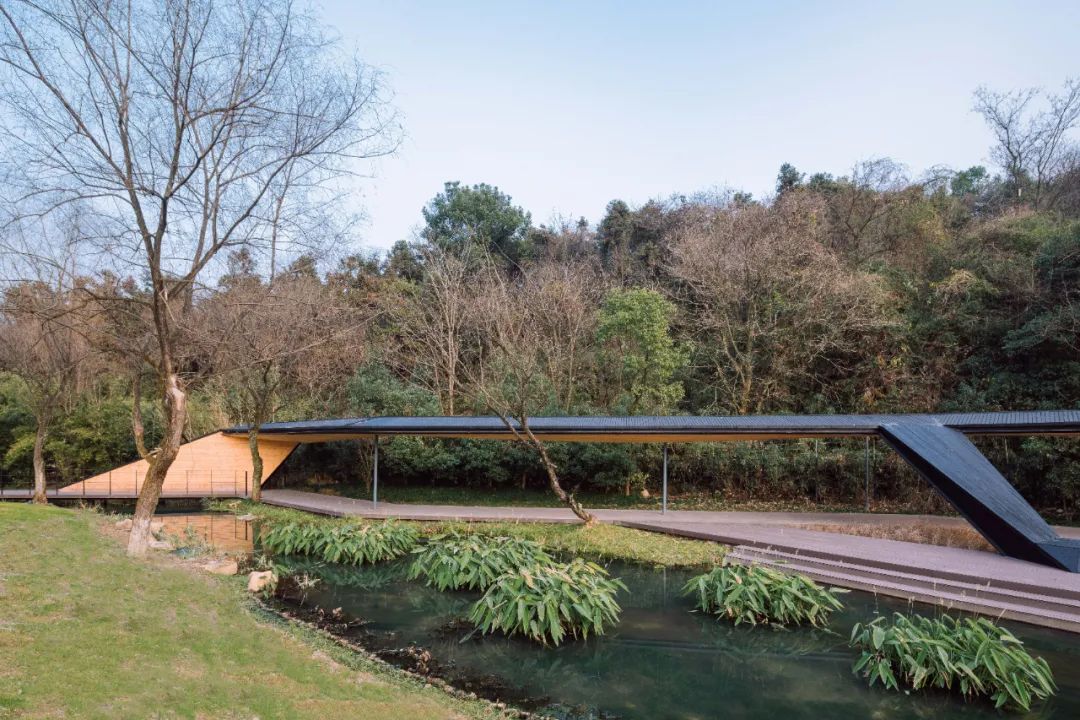
There is a natural
transition between the Brook and the traffic and pedestrian roads in the middle
of the campus as well as the Cloud Corridor in the Valley of Music through the
lawn buffer zone, bush buffer zone and the brook landscape belt. Combined with
the design of the corridor without contact with water, the natural gentle slope
on both sides of the corridor enters the water by steps on brook bank without
disturbing the growth of aquatic plants. Through the comprehensive purification
of plants and sand, the water quality of natural precipitation can be improved,
and the water gradually infiltrated into the soil to conserve groundwater and
supply landscape water.
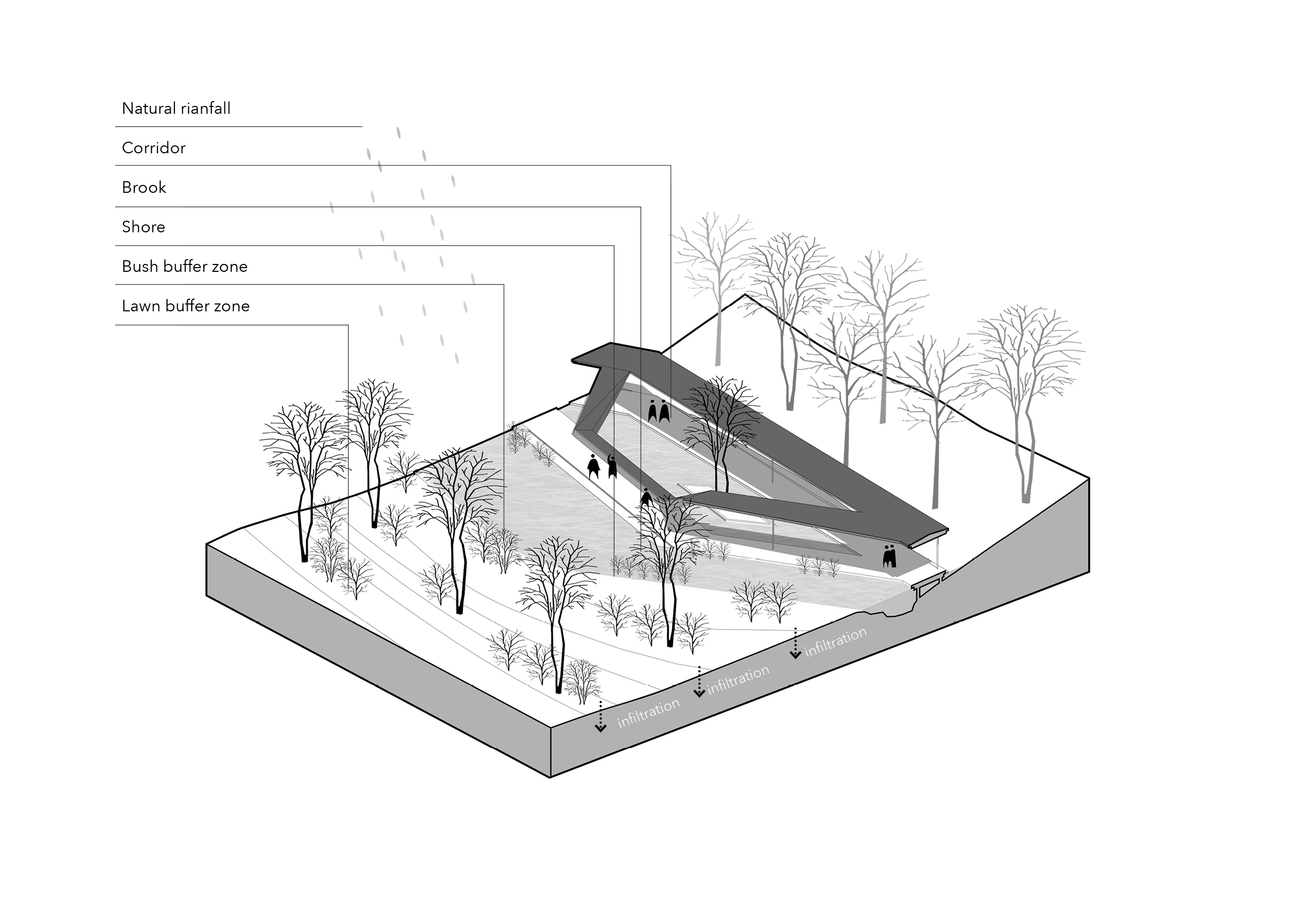
△ Design of sponge landscape systems
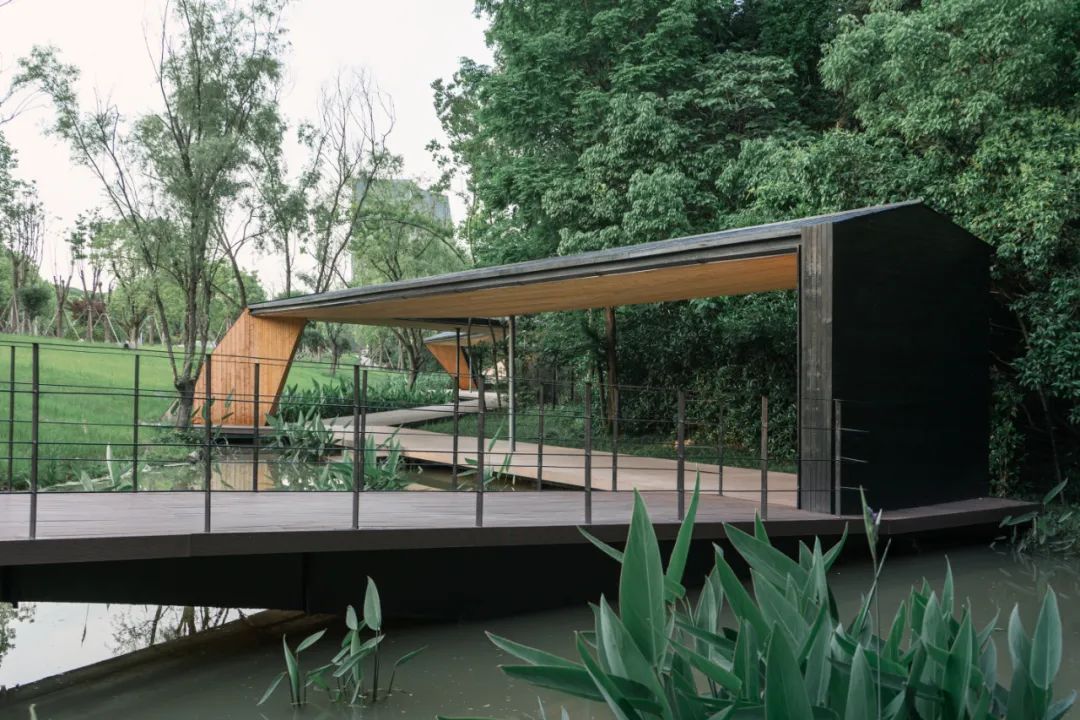
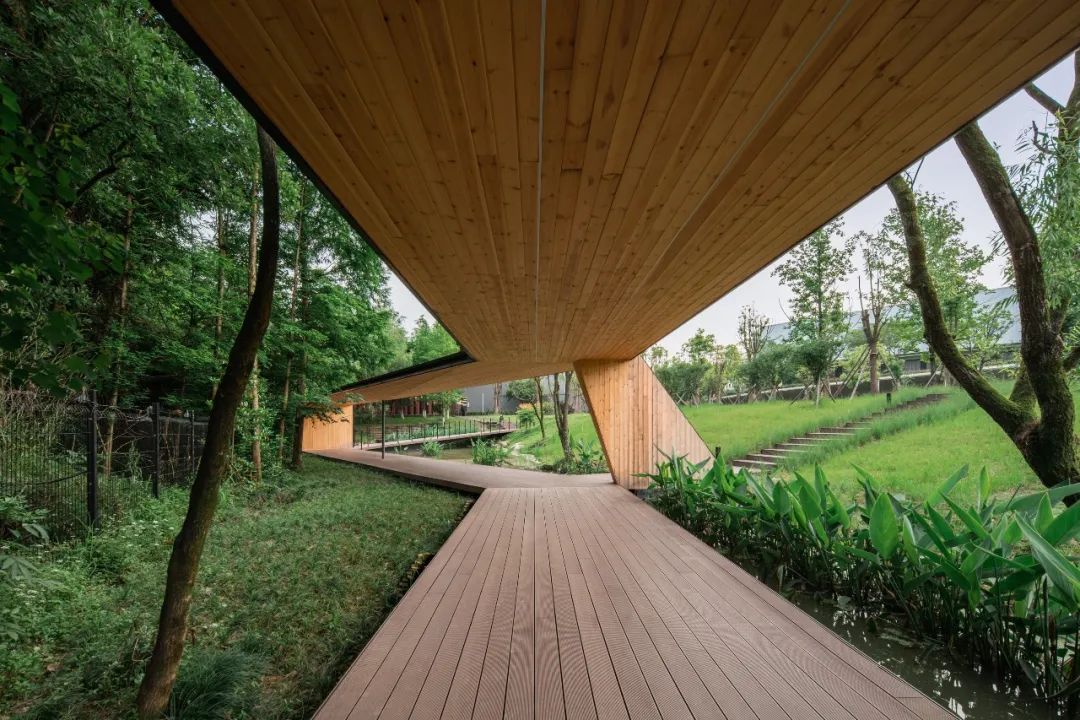
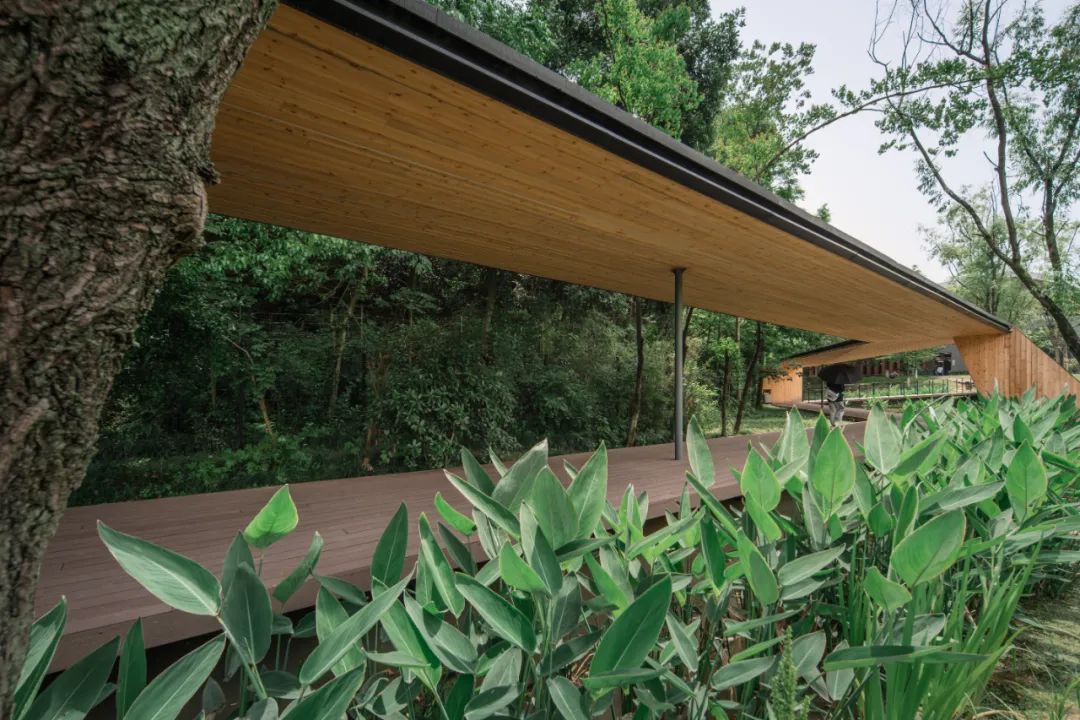
| 04 |
New Chapters of Old Songs: Campus
open to public
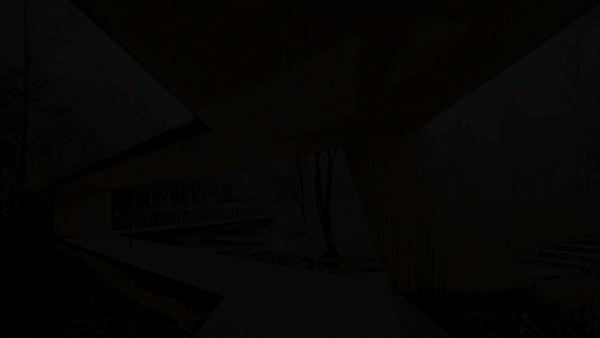
Floating Cornice on
the Brook is a freedom and openness public space was built for Zhejiang
Conservatory of Music, which re-envision the campus' construction that was
completed several years ago. Floating Cornice on
the Brook serves teachers and students with the improved campus infrastructure,
and integrates natural resources and seasonal landscape scenes to benefit the
public. With new forms, structures and materials, it forms an interesting
east-west dialogue with the original Cloud Corridor in the Valley of Music,
completes the linear open space in the middle of the campus, and connects the
buildings in the north and south areas. Thus, a public culture and art space
that is open and shared with the city and permeated with the nature is formed.
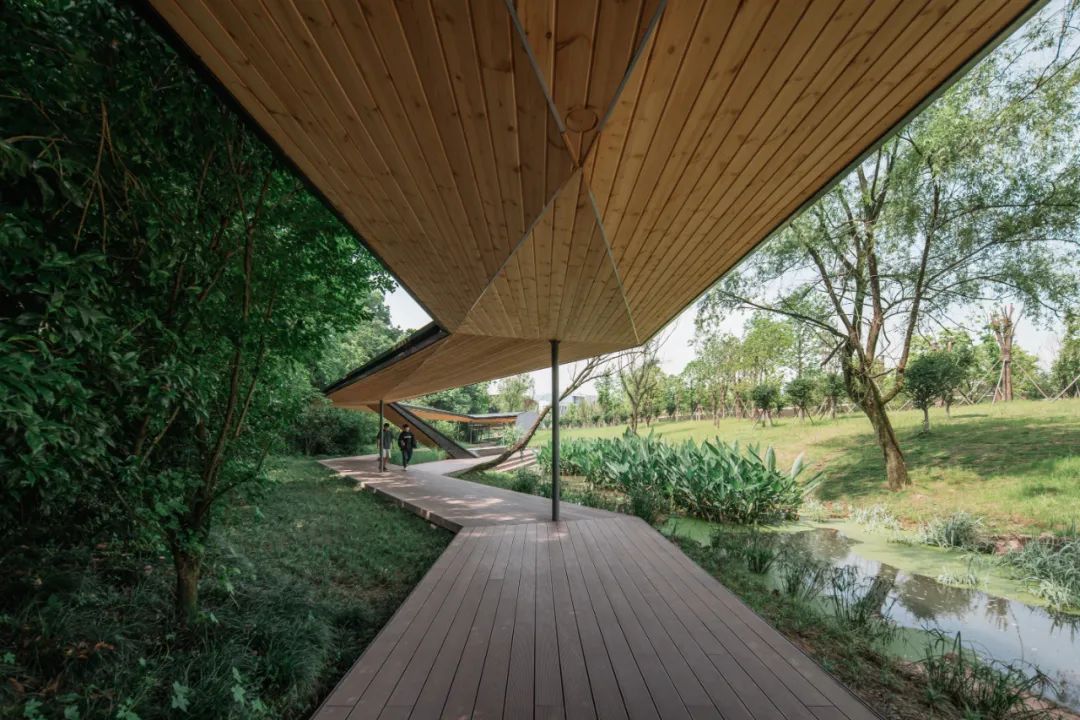
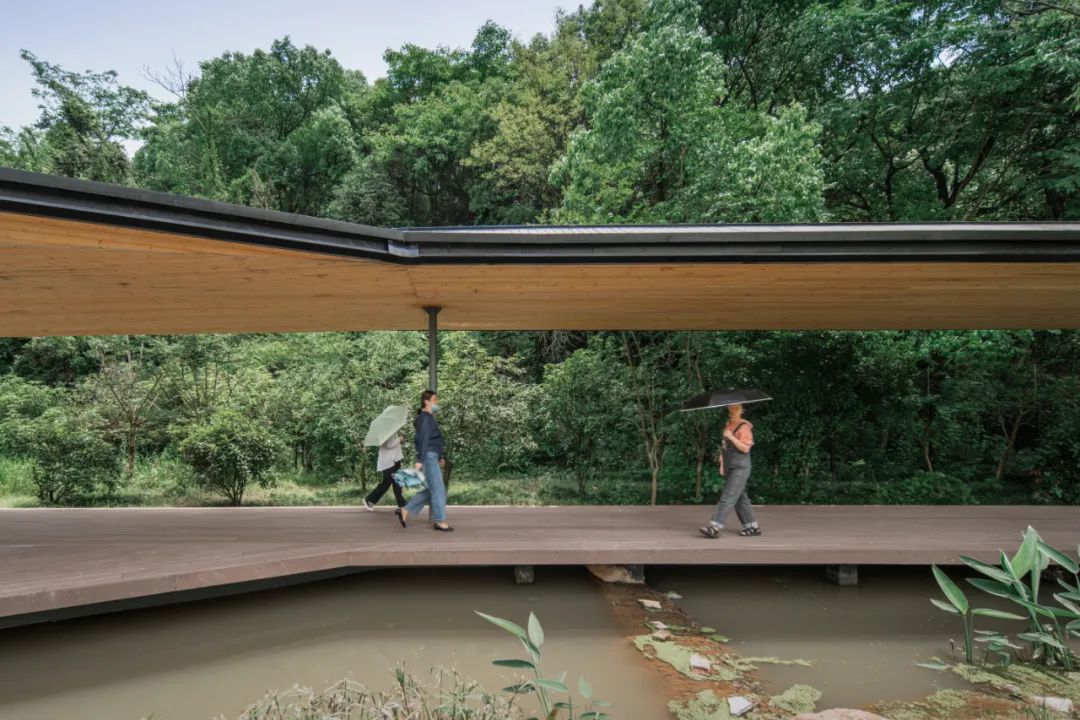
Being open for use
over the years, Zhejiang Conservatory of Music has held many national and
provincial music and art activities for the public. Within the macro scale of
the art park, Floating Cornice on the Brook improves the campus infrastructure
and artificial ecological environment by constructing a natural rhythmic
walking corridor, benefiting various public groups. In the microscopic scale of
regional ecology, it is a rest space based on biodiversity.
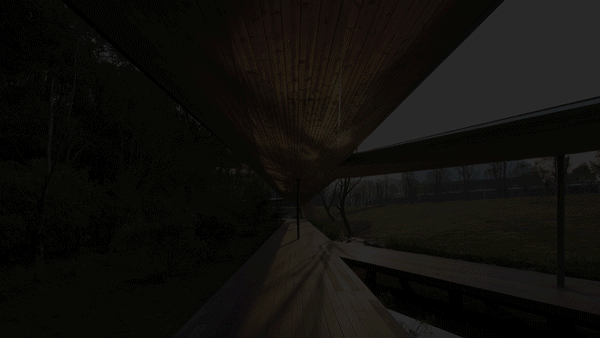
As the poem says:
"Nature is full of the image of time, nature stays, and time flies, all
from the perfect; So the light from above shines on mankind like the flowers
near the trees."
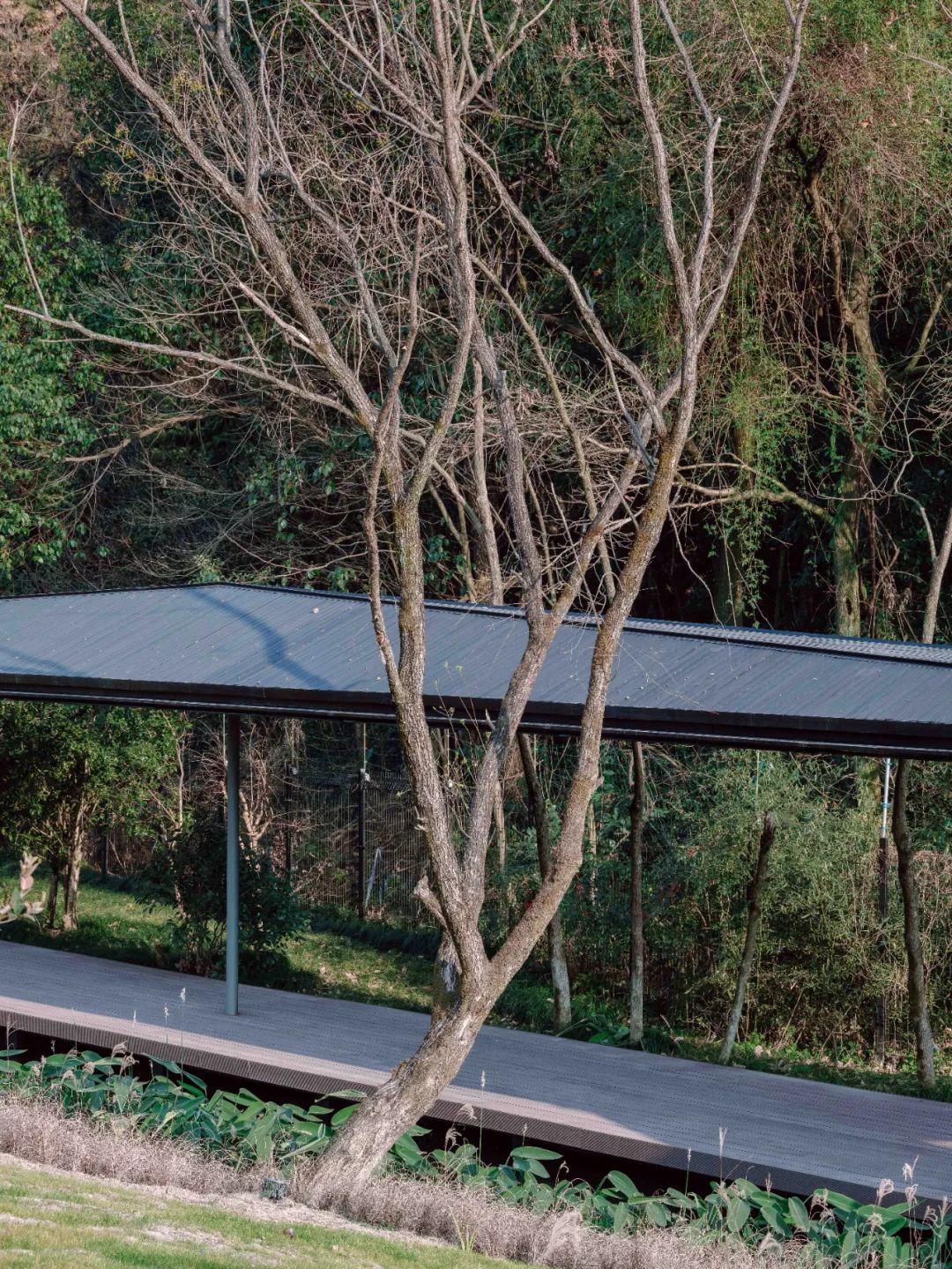
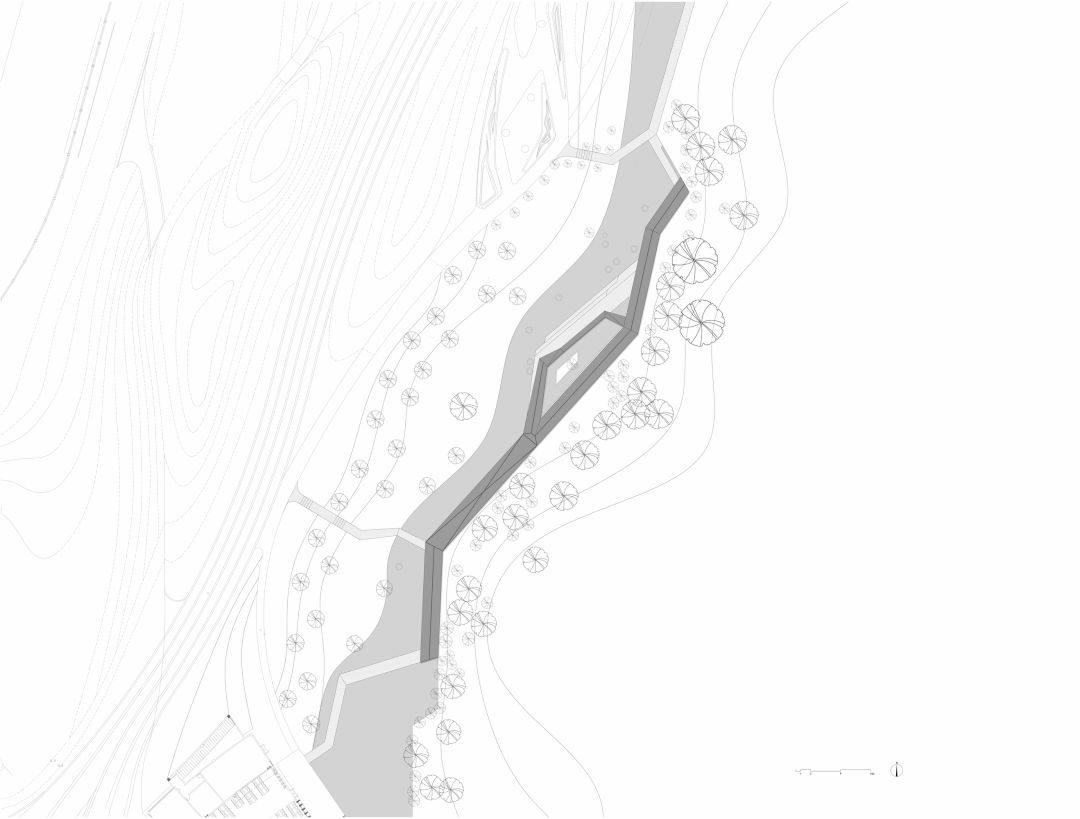
△ Site Plan

△ Ground Floor
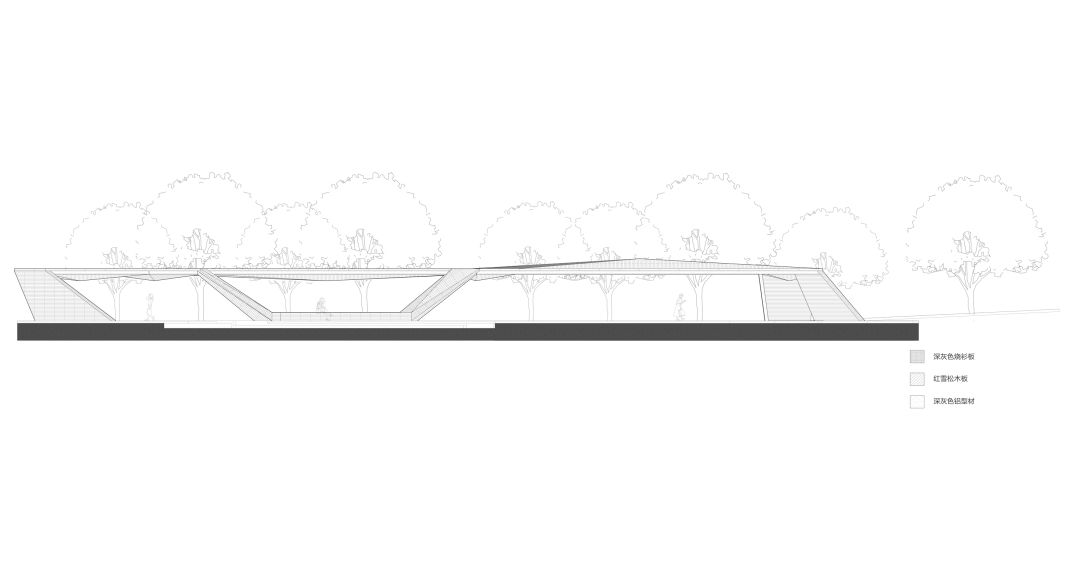
△ Elevation